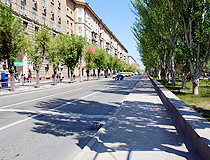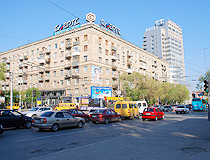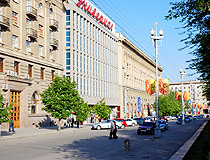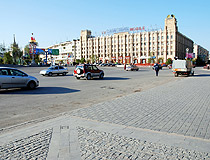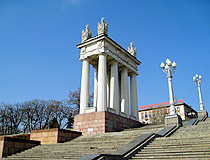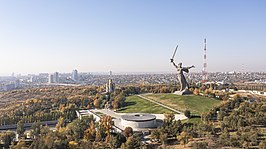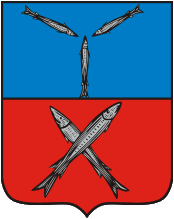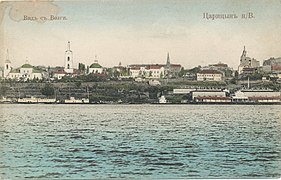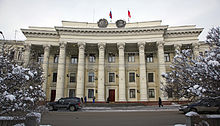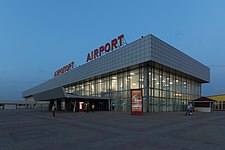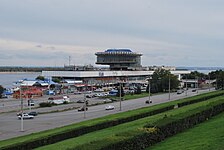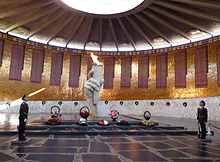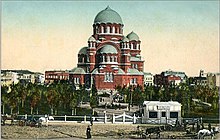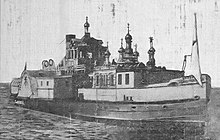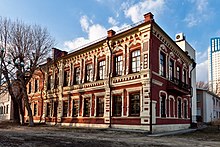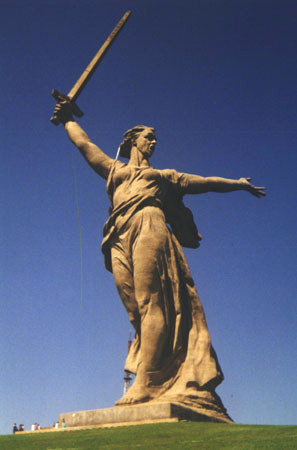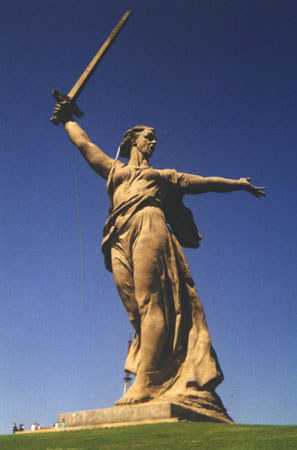Volgograd is the capital of the Volgograd region [Волгэгрэд ис зэ кэпитал оф зэ Волгэград риджин] – Волгоград это административный центр Волгоградской области.
The city is the longest one in Russia, it is length is about 90 kilometers [Зэ сити ис зэ лонгест уан ин Раша, ит ис ленф ис эбаут найнтин километэрс] – Этот город является одним из самых протяженных в России, его протяженность составляет около 90 километров.
The city was built as a fortress in 1589 and called Tsaritsyn [Зэ сити вос билт эс э фотрис ин фивтин эйтин найн энд колд царицын] – Город был основан как крепость в 1589 году и назван Царицын. In 1925 the city received a new name, Stalingrad [Ин найнтин твенти файв зэ сити ресивд э нью нэйм, Стэлингрэд] – В 1925 году город получил новое название, Сталинград.
Volgograd has the status of “Hero City” [Волгэгрэд хэс зэ статус оф хироу сити] – Волгоград имеет звание Города-героя. In 1942 the city became the scene of an epic battle of World War II [Ин найнтин фоти ту зэ сити бикейм зэ сцин оф эн эпик батл оф Ворлд Вор ту] – В 1942 году город стал ареной легендарной битвы Второй Мировой Войны.
Square of the Fallens [Сквэа оф зэ фолэнз] – Площадь Павших борцов
It is the central and largest square of Volgograd [Ит ис зэ сэнтрал энд ладжест сквэа оф Волгэгрэд] – Это центральная и самая большая площадь Волгограда.
The Mamai Hill [Зэ Мамэй Хилл] – Мамаев Курган
It is a symbol of the city, architectural-and-sculptural complex is about 26 hectares [Ит ис э симбол оф зэ сити акитэкчэ-энд скалптчурал комплекс ис эбаут твенти сикс хэктэз] – Это символ города, архитектурно-скульптурный комплекс занимающий около 26 гектар.
The Motherland Calls [Зэ мазэлэнд колс] – Родина Мать зовёт
The height of this sculpture is 85 m [Зэ хейт оф вис скалпчэ ис эйтин фивтин метэс] – Высота этой скульптуры составляет 85 метров. It is the tallest statue of a woman in the world [Ит ис зэ толест статью оф э вумен ин зэ ворлд] – Это самая высокая статуя женщины в мире.
Volga–Don Canal [Волгэ-Дон кэнэл] – Волго-Донской канал
The canal connects the Volga and the Don rivers [Зэ кэнэл конэктс зэ Волга энд зэ Дон риверс] – Этот канал соединяет реки Волгу и Дон. Volga-Don Canal opened in 1952, the length of the waterway is 101 km [Волга-Дон кэнэл оупенд ин найнтин фивтин ту, зэ ленф оф зэ вотэвэй ис уан хандрид энд уан] – Волго-Донской канал открыт в 1952 году, протяженность водных путей составляет 101 км.
The Heroes` Alley [Зэ хирос Алли] – Аллея героев
On one side of the Alley a memorial to 192 heroes of the Soviet Union born in Volgograd [Он уан сайд оф зэ Алли э мемориал моньюмент ту уан хандрид ту хирос оф зэ Совьет Юнион] – На одной стороне аллеи Мемориал 192 Героям Советского Союза, родившимся в Волгограде.
On the other side there is a monument to 127 heroes of the Soviet Union who got the title during Stalingrad Battle [Он зэ авэ сайд вэа ис э моньюмент ту уан хандрид твенти севен хирос оф зэ Совьет Юнион ху гот зэ тайтл дьюрин Стэлингрэд Батл]- На другой стороне есть памятник 127 Героев Советского Союза, которые получили это звание в ходе Сталинградской битвы.
History of Volgograd
Prehistory of the founding of Volgograd
The birth of the city was given by the Volga trade route, the Don-Volga Portage and shipping on the Volga River, which began to take shape back in the 10th century, when Rus’ (in the upper Volga), Volga Bulgaria (in the Middle Volga) and Khazaria (in the Don-Volga interfluve and the lower Volga) became their main participants. The role of merchants was played by the Varangians and Arab merchants.
By the end of the 10th century, the Volga trade was disrupted due to the waves of resettlement of the Pechenegs (from the 950s), the Polovtsians (from the 1100s), the Mongol invasion (1236-1243). The Volga trade route was revived after the Mongol conquest, when the entire river was under the control of the Ulus of Jochi (the Golden Horde). Here, three trade routes from north to south and a route from east to west began to intersect. In 1260, this factor of a convenient trade location was used when Sarai Berke, the capital of the Golden Horde, was founded. It was located about 60 km from present-day Volgograd.
On the site of today’s Volgograd there was a settlement of the Golden Horde with an unknown name. Volgograd is not the successor of this settlement. It was located about 18 km north of the historical core of Volgograd and ceased to exist 200-250 years before its foundation.
In the 15th century, the Golden Horde began to disintegrate into independent khanates: Kazan, Siberian, Astrakhan, Crimean, and others. In the 16th century, the Tsardom of Russia, on the contrary, went through a period of centralization, it became stronger and conquered the khanates one after another: Kazan in 1552, Astrakhan in 1556, Siberian in 1598. At the time of the founding of Volgograd (Tsaritsyn), only the Crimean Khanate remained unconquered.
More Historical Facts…
Foundation of Volgograd
The trade route along the Volga was revived again. Russia exported timber, grain, cloth, leather, wax, and honey through Astrakhan, and imported salt, fabrics, metals, and incense. The Volga became a transit route for international trade as well. The first mention of Tsaritsyn, as a seasonal guard post on Tsaritsyno Island, reached us in a letter from the merchant Christopher Burrow, written in 1579.
In 1585-1590, voivode Grigory Zasekin founded a number of permanent fortresses with garrisons of 100-150 people along the Volda. Today, some of them are large regional centers: Volgograd (Tsaritsyn), Samara and Saratov. The Tsaritsyn fortress also controlled the eastern side of the Don-Volga Portage — the shortest (about 70 km) distance between the Don and Volga rivers. The instructions of Tsar Fyodor Ioannovich on its development date back to 1589. This year is considered the year of Volgograd’s founding.
In 1718-1720, by order of Peter I, the Tsaritsyn fortified line was built from the Volga to the Don. Until the 1750s, the Volga-Don region was a buffer zone between the provinces of the Russian Empire north of Voronezh and the nomads and khanates of the Caucasian and Central Asian regions. During this period, Tsaritsyn remained a border settlement with military-administrative functions: supply depots for the waterway, quarantine of sick people from passing ships, and small trade. The main population was the military — up to 400 people, and a small number of civilians.
After the reforms of Peter the Great and the formation of the Russian Empire, Russian expansion into the Crimea, the Caucasus and Central Asia began. The year 1775 can be considered a new stage in the development of Tsaritsyn, when the Tsaritsyn fortified line and the Volga Cossack army were abolished and the Azov-Mozdok fortified line took over the function of the southern border of the country.
Volgograd in the 19th century
In 1820, a new urban development plan of Tsaritsyn was approved without a fortress wall and ramparts. From this period, the settlement of the adjacent territory by peasants from the central provinces began. In addition to Russians, German colonists settled here, invited by Catherine the Great. They brought with them new technologies and a new way of life.
The first school, pharmacy, coffee shop, the first planting of potatoes, mustard and tobacco in the Tsaritsyn region took place in the German colony of Sarepta-on-Volga, located 30 kilometers south of Tsaritsyn. Until the middle of the 18th century, the food industry developed primarily in Tsaritsyn, which was facilitated by the proximity of the Elton salt mines, the fish resources of the Volga and the Caspian Sea, and melon growing.
After the abolition of serfdom in 1861, the town’s industry began to grow rapidly, which was facilitated by the factors of convenient transport — the Volga and a developed railway network, and the terrain — a flat undeveloped steppe. This made it possible to build huge industrial complexes with their own infrastructure and workers’ settlements. In May 1862, the Volga-Don railway was commissioned, which connected the Volga and Don along the shortest distance and laid the foundation for the rapid industrial growth of Tsaritsyn.
In 1880, on the site of the present Central Park of Culture and Leisure, the oil refining complex with the largest oil storage facilities in the Russian Empire was built by the company “Nobel Brothers” (it became known as the Nobel town). Tsaritsyn became an important oil hub. Here, Caspian oil was poured from river tankers into railway tank cars for transportation to the European part of the Russian Empire. The availability of crude oil gave impetus to the development of oil refining. With the assistance of the British company “Vickers”, the Tsaritsyn gun factory was built (sea and field artillery of large calibers).
By 1913, Tsaritsyn in terms of the number of residents, more than 110,000, overtook many regional centers of the Russian Empire. It was a period of rapid growth in the construction of residential, industrial, public, and entertainment buildings, hospitals, schools, hotels. The infrastructure also developed rapidly: the electric network (1880), the telephone (1885), the water supply (1890), the movie theater (1907), the city tram (1913).
Volgograd in 1917-1940
The growth of population and housing development was interrupted with the outbreak of the First World War and the subsequent Russian Civil War. Due to the presence of large-scale industry, there were significant masses of workers who sympathized with the Bolsheviks, which contributed to the rapid establishment of their power in the city. Soon Tsaritsyn became a “red” outpost in the south of Russia. Fighting in the vicinity and city limits of Tsaritsyn caused significant damage to the city economy and residents.
In 1921 and 1922, the grain harvest suffered from drought and famine struck the city. Famines had happened before, but this time the consequences were aggravated by the forcible withdrawal of grain for the needs of the Red Army and the introduction of the policy of war communism.
Foreign charitable organizations provided enormous help in saving Tsaritsyn from starvation: the American Relief Administration, the International Working Committee, the Italian and Swiss Red Cross missions. In April 1922, at the peak of the famine, they opened 853 canteens in Tsaritsyn and the province, where 668,900 people received hot meals or dry rations — about half of the total population.
Even during the battles of 1919, the Soviet government took into account that in terms of population and industry, the city had long outgrown its district status, and this year the Tsaritsyn Governorate was formed. At the end of the Civil War, a peaceful life began to improve, forced “grain surplus” appropriation and elements of war communism were canceled, economic relations began to be determined by the New Economic Policy. Agriculture and industry were actively reviving and the city restored the rate of population growth.
On April 10, 1925, during a mass renaming campaign and getting rid of everything connected with the monarchy and religion, in honor of the recognition of Stalin’s merits in the defense of the city during the Civil War, Tsaritsyn was renamed Stalingrad.
As part of the industrialization of the USSR, in Stalingrad, the State District Power Plant (1929), the Tractor Plant (1930), the Shipyard (1931), and the Hardware Plant (1932) were built in a short time. The already existing factories were included in the Stalingrad tractor and tank cluster. The Stalingrad Tractor Institute was established to train engineers and workers in 1930. Two similar clusters were deployed on the basis of the Chelyabinsk Tractor Plant and Kharkov Tractor Plant.
The Stalingrad Tractor Plant was designed according to the project of the American architect Albert Kahn, the first tractor of the plant was the STZ-1 (licensed copy of the American McCormick Deering 10/20 tractor), the first tank was the T-26 (licensed British tank Vickers Mk E). In the first half of the 1930s, Stalingrad engineers launched production of new models: the STZ-3 tractor (1937) and the legendary Soviet tank T-34 (1940).
Volgograd during and after the Second World War
From July 17, 1942 to February 2, 1943, on the outskirts of Stalingrad and in the city itself, one of the most important battles of the Second World War took place — the Battle of Stalingrad. By the number of total irrecoverable losses (killed, died of wounds in hospitals, missing), it became one of the bloodiest in the history of mankind.
Soviet soldiers — about 500,000, German soldiers — about 300,000, German allies (Italians, Romanians, Hungarians, Croats) — about 200,000 people, the number of killed city residents cannot be estimated even approximately, no less than tens of thousands. The military significance of the Soviet victory was the removal of the threat of seizure by the Wehrmacht of the Lower Volga region and the Caucasus, especially the Baku oil fields.
The damage caused by the war was enormous: 41,685 houses were destroyed (90%), only 32,181 residents of the pre-war 450,000 remained in Stalingrad (of which 30,666 were in the least affected Kirovsky district). Sapper units left for the demining of the city defused more than 300 thousand mines and 1 million shells and bombs. It was only by July 1945 that it became safe to move around the city.
After the war, it was decided to prioritize the allocation of captured German construction equipment and property to Stalingrad. For example, the children’s railway received the HF110C steam locomotives of the Wehrmacht railway troops.
A significant part of the restoration work was carried out by prisoners of war. The last of them were released in 1949, except for those with criminal sentences for personally committed war crimes. By 1949, the volume of industrial production in Stalingrad exceeded the pre-war level.
Volgograd in the second half of the 20th century and beyond
The 1950s were the heyday of Stalingrad’s architecture. In the first post-war years, the most necessary objects were rebuilt, and from the beginning of the new decade, large-scale construction of monumental buildings in the Stalinist Empire style began. In this decade, the image of Stalingrad as an exemplary socialist city was created. The entire historical center of the city, the Stalin district, was rebuilt in one style.
The Volga-Don Canal, put into operation in 1952, became another symbol of the city. After Stalin’s death in 1953, during de-Stalinization, all the monuments to Stalin were demolished, all objects named in his honor were renamed. On November 10, 1961, Stalingrad was renamed Volgograd.
By the end of the 1950s, there was a gradual rejection of the Stalinist Empire style in architecture. New buildings began to be constructed in a more functional style. To speed up the solution of the housing problem in the USSR, serial production of standard apartment buildings in the form of prefabricated panels began. Unofficially called Khrushchyovkas, they were built in large numbers in all districts and micro-districts of Volgograd without exception. Today, they constitute a huge part of the housing stock of the city.
In 1967, in memory of the Battle of Stalingrad, the memorial complex Mamayev Kurgan was built. A modern transport infrastructure began to take shape, where the main role belonged to road transport. The dismissal of Khrushchev and the beginning of Brezhnev’s rule in 1964 did not cause obvious changes in the architecture of the city. In the beginning of the 1970s, the economy of the USSR entered a period of stagnation.
In 1989, the millionth resident of Volgograd was born. September 2-3, 1989, Volgograd celebrated its 400th anniversary. Starting this year, it has become a tradition to celebrate the City Day of Volgograd on the first weekend of September.
After the collapse of the USSR in 1991, a rapid decline began in the industries of the city and its urban economy. All public construction was frozen. For a decade some objects were in a state of protracted construction.
Construction again intensified in the mid-2000s. In 2018, Volgograd hosted 4 matches of the FIFA World Cup. For this, a modern stadium “Volgograd Arena” with a capacity of 45,000 people was built.
Streets of Volgograd
On the street in Volgograd
Busy intersection in Volgograd
Author: Victor Belousov
Volgograd cityscape
Author: Igor Kurylko
Volgograd — Features
Volgograd is located in the lower reaches of the Volga River on its western bank with various forms of relief. The part of the city adjacent to the Volga is low-lying, with a height of 0-40 meters above sea level, at a distance of 1-3 kilometers from the Volga there is a chain of gentle hills (50-140 meters): Mamaev Kurgan (102 meters), Lysaya Gora and others.
The city got its original name (Tsaritsyn) from the Tsaritsa River, which flows into the Volga. The name was probably based on the Tatar words “sari-su” (yellow river) or “sari-chin” (yellow island), since a Russian settlement with a wooden fortress originally arose on Tsaritsyn Island.
In 1965, after Volgograd received the status of a hero city, its coat of arms that is still in use was adopted: in the upper red field — the Star of the Hero and the battlements of the fortress wall symbolizing the Stalingrad fortress, in the lower blue field — a gear wheel and a sheaf of wheat, as symbols of advanced mechanical engineering and agriculture.
The climate in Volgograd is moderately continental. Winters are mild, with frequent thaws, summers are hot and long. In all seasons, sharp temperature changes are possible. The average temperature in February is minus 5.9 degrees Celsius, in July — plus 24.2 degrees Celsius.
After the collapse of the USSR, the industrial potential of Volgograd significantly decreased. Traffic on the Volga-Don Canal dropped significantly in 1990-2010. However, now it is close to record numbers again.
Volgograd is an important junction of highways leading to Moscow, Astrakhan, Syzran, Elista, Samara, Donetsk (Ukraine). Volgograd airport “Gumrak” is located about 20 km from the city center and offers regular flights to such cities as Moscow, St. Petersburg, Sochi, Krasnodar, Kaliningrad, Ufa, Nizhny Novgorod, and a number of others.
The specificity of the Volgograd road network comes from its unusual shape: a built-up strip with a width of 1 to 5 and a length of about 90 kilometers, in which multi-storey buildings, private residential buildings, industrial zones, and areas of undeveloped steppe alternate several times. Public transport in Volgograd is represented by buses, trams, trolleybuses, minibuses, as well as an underground high-speed tram — a kind of analogue of the metro.
Tourism in Volgograd
Today, Volgograd is quite an interesting place from a tourist point of view. Here you can see the largest river island in Europe, the only underground tram in Russia, the largest river port in Europe, and unique museums. In addition, Volgograd attracts tourists with its natural and climatic conditions and recreational resources — a huge water area, kilometers of sandy beaches and more than 200 sunny days a year.
Volgograd has the tallest sculpture-statue in Europe — the famous Motherland Calls monument, one of the largest monuments to a person who actually lived — a 57-meter-high monument to Lenin, installed at the entrance to the Volga-Don canal, the longest street in Russia — Vtoraya Prodolnaya magistral (more than 50 km), the longest residential building in the world (1,142 meters).
On the territory of Volgograd Oblast, you can visit the amazing lake of lotuses (flowering period: August-September), Lake Elton, “Volga Switzerland” — the natural park Shcherbakovsky, as well as the natural parks “Tsimlyanskie Sands”, “Donskoy”, “Nizhnekhopersky”, “Ust-Medveditskiy”, etc. Today, Volgograd is one of the twenty most popular Russian tourist destinations.
To help those traveling in the Volgograd region, there are two tourist information centers in the city. The first one is located at Gagarina Street, 12, not far from the Volgograd Planetarium, and the second — in the museum-reserve “Staraya Sarepta” (Izobilnaya Street, 10).
Traditional Volgograd souvenirs can be found in shops and kiosks on Mamayev Kurgan, in Staraya Sarepta and other museums in the city. Usually tourists buy small figurines in the form of the Motherland Monument, St. George ribbons and other items related to the glorious military past of the city.
Main Attractions of Volgograd
Mamaev Kurgan and the statue “The Motherland Calls!” In the very center of Volgograd, on the right bank of the Volga, Mamayev Kurgan (hill) rises — the place of the fiercest fighting during the Stalingrad Battle. Each of the belligerents tried at all costs to take and hold this strategically important height.
The central element of the monument-ensemble “The Heroes of the Battle of Stalingrad” on Mamayev Kurgan is the statue “The Motherland Calls!” — a grandiose statue of a woman with a sword in her hands, 85 meters high. In addition to it, the ensemble includes the Square of Those Who Fought to Death, the Hall of Military Glory with an eternal flame, Ruined Walls, the Square of Heroes, and the Square of Sorrow.
There are also several mass graves on Mamayev Kurgan, in which the ashes of more than 35 thousand defenders of Stalingrad rest. A staircase of 200 granite steps leads from the foot of the hill to its top — the number of days of the Stalingrad Battle.
Museum-Panorama “The Battle of Stalingrad”. In the 8 halls of this museum, Soviet and German weapons, military equipment, uniforms, battle flags, photographs, and documents are exhibited. The main exhibit of the museum is a huge panoramic painting “The Defeat of the German Troops in Stalingrad” devoted to the fighting for Mamayev Kurgan.
The first version of the painting was created in 1948-1950. Completed only in 1982, it became the largest battle painting in the Soviet Union. The viewers of the panorama are, as it were, on the top of Mamayev Kurgan and see all the surroundings and the events of January 26, 1943. Some of the exhibits are displayed in the open air: military equipment, several monuments. Imeni Marshala V.I. Chuykova Street, 47.
Gerhardt’s Mill. Near the museum-panorama “The Battle of Stalingrad”, you can see the ruins of a 5-storey brick building. Before the Second World War, it housed a mill that belonged to the Volga German A. Gerhardt. The war turned this building into what we see today.
Its walls are covered with traces of bullets and shell fragments, the roof and part of the ceilings have collapsed, the empty eye sockets of the windows are distorted by explosions. The building was left in a dilapidated state as a reminder of what happened here during the Second World War, as a monument to the heroism of the city’s defenders.
Fountain “Barmaley” — one of the most famous fountains in the world created on the basis of the tale of Korney Chukovsky “Barmaley” and consisting of figures of children dancing around a huge crocodile. The original fountain was created in 1930. In 2013, two replicas of the fountain were installed in its memory: near the Gerhardt’s mill and on the square near the railway station of Volgograd (Privokzalnaya Square, 1), where the original fountain once stood.
Embankment named after the 62nd Army. The central embankment of Volgograd got its name in honor of the 62nd Army, which defended the riverside during the Battle of Stalingrad. The Volgograd embankment is considered one of the most beautiful on the Volga. It consists of two levels: the first one is directly adjacent to the river, the second one runs near residential buildings. The most beautiful place on the embankment is its central stairs, built after the war and called the “front gate” of Volgograd.
Volgograd River Station — the largest river station in Russia and Europe (296 m long and 47 m high). Inside there is a concert hall for almost 1,000 spectators where organ music concerts are held. In addition, there are cafes, restaurants, a fitness center, and nightclubs. However, ships continue to dock here: a trip along the Volga River, during which you can enjoy the panoramas of Volgograd from the water, takes about one hour. Embankment of the 62nd Army Street, 6.
Pictures of Volgograd
Volgograd architecture
Author: Victor Belousov
In the center of Volgograd
Author: Victor Belousov
Colonnade and stairs on the central embankment of Volgograd
Author: Igor Kurylko
Pavlov’s House — a residential building famous for the fact that during the Battle of Stalingrad a group of Soviet fighters defended it for 58 days. The soldiers were led by senior sergeant Yakov Pavlov, hence the name of the building. In 1985, in honor of the 40th anniversary of the Victory, a memorial wall was erected next to it from the original material. Lenin Square (Sovetskaya Street, 39).
Volgograd Memorial Historical Museum. The collection of this museum is exhibited in a mansion (1903) that once belonged to the Repnikov merchant family. The building itself is a valuable architectural monument constructed in the new Russian style from bright red bricks.
This museum has more than 1,000 exhibits that tell primarily about the events of 1917-1923. Here you will see paintings and graphics from the Russian Civil War, military posters and historical photographs, leaflets and rare books, collectible coins, postage stamps and postcards, household items of the early 20th century. Gogol Street, 10.
Museum of Fine Arts named after Ilya Mashkov. The collection of this art gallery has paintings of the 18th-20th centuries. The history of Russian landscape painting is well represented here. There is a separate section dedicated to the works of Volgograd painters. Lenin Avenue, 21.
Tower of the Tsaritsyn Fire Brigade. This architectural structure of the late 19th century was built in an eclectic style. It is an excellent observation deck, from a 36-meter height you can see most of the city’s streets and the Volga Hydroelectric Station. Visiting the observation deck is carried out by excursion groups from the Museum of Local Lore (Lenin Avenue, 7). Kommunisticheskaya Street, 5.
Museum-Reserve “The Old Sarepta” — an open-air museum covering an area of 5 hectares and located on the site where the German colony of Sarepta-on-Volga was located in the past, about 30 km from the center of Volgograd. The memorial complex includes 26 buildings, 23 of which are architectural monuments of federal importance. It was organized for preserving the architectural heritage of the 18th-19th centuries, as well as reviving the traditions of the peoples of the Volgograd region.
The museum collection consists of ethnographic, archaeological and artistic exhibits. On the territory of the museum there are excursion programs that will help you learn the history, culture and way of life of the people of Sarepta. Here you can also listen to organ music, visit the Mustard Museum, and other interesting exhibition halls.
Volga-Don Canal. About one kilometer from “The Old Sarepta”, you can find the arch of the first sluice of the Volga-Don Canal. This is a kind of “gate” of the canal, reminiscent of a triumphal arch. The height of the structure is 40 m. More information about the canal can be found in the nearby Museum of the History of the Volga-Don Navigable Canal.
Near the approach to the sluice, a monument to Vladimir Lenin is erected (previously there was a monument to Joseph Stalin) — the largest among the monuments to people who actually lived (57 m). On the other side of the canal there is a monument-lighthouse to the sailors of the Volga military flotilla, who defended Tsaritsyn, and later Stalingrad.
Kazan Cathedral (1896-1899) — a picturesque building constructed in the eclectic style, combining the architectural styles of different eras. Perhaps that is why it looks so festive and picturesque. In 2010, the cathedral was restored to its original appearance during the reconstruction. Lipetskaya Street, 10.
Volgograd Underground Tram. The Volgograd high-speed underground tram, also known as the metro-tram, is a unique type of urban transport. This is essentially a hybrid of a metro and a tram: most of the route of two-car trains runs underground (there are only two ground stations).
Except for Volgograd and Krivoy Rog (Ukraine), such a project was not implemented anywhere else, and therefore it became a tourist attraction of Volgograd. Today, it passes through five districts and includes 22 stations. The metro-tram of Volgograd carries over 50 million passengers annually.
Probably not every resident of our country knows about such a wonderful city as Volgograd. This city is located in the southeast of the European part of the Russian Federation. It was here that the famous Battle of Stalingrad took place. It is located on the right bank of the Volga River. The Volga-Don Shipping Canal, which connects the Volga River with the Don River, originates here. The central embankment of Volgograd is an adornment of the city with front gates. Now this city is a million megalopolis. It has become an industrial, and logistics, and scientific, as well as a cultural center. Volgograd is a vibrant and vibrant city. Walking along its streets, it is impossible not to be imbued with a sense of pride and patriotism. There is a large selection of universities where everyone can choose an interesting profession. There are also modern cinemas. A lot of different restaurants, bars and cafes. Well, theaters are made in ancient classical styles. This is the most wonderful city and everyone must visit it!
Наверное, не каждый житель нашей страны знает о таком замечательном городе, как Волгоград. Этот город расположен на юго-востоке европейской части Российской Федерации. Именно здесь и произошла знаменитая Сталинградская битва. Расположен он на правом берегу реки Волги. Здесь берет свое начало Волго-Донской судоходный канал, соединяющий реку Волгу с рекой Дон. Центральная набережная Волгограда, является украшением города с парадными воротами. Сейчас этот город миллионный мегаполис. Он стал и промышленным, и логистическим, и научным, а так же культурным центром. Волгоград — это живой и динамичный город. Прогулившись по его улочкам, невозможно не проникнуться чувством гордости и патриотизма. Здесь есть большой выбор вузов, где каждый может выбрать интересную профессию. А еще имеются современные кинотеатры. Очень много различных ресторанов, баров и кафе. Ну а театры выполнены в старинных классических стилях. Это самый замечательный город и его обязательно нужно посетить каждому!
|
Volgograd Волгоград |
|
|---|---|
|
City[1] |
|
|
Top-down, left-to-right: The Motherland Calls on Mamayev Kurgan, the railway station, Eternal flame, The Metrotram, Gerhardt’s Mill, Central embankment |
|
|
Flag Coat of arms |
|
| Anthem: none[3] | |
|
Location of Volgograd |
|
|
Volgograd Location of Volgograd Volgograd Volgograd (European Russia) Volgograd Volgograd (Europe) |
|
| Coordinates: 48°42′31″N 44°30′53″E / 48.70861°N 44.51472°ECoordinates: 48°42′31″N 44°30′53″E / 48.70861°N 44.51472°E | |
| Country | Russia |
| Federal subject | Volgograd Oblast[2] |
| Founded | 1589[4] |
| City status since | 1780[1] |
| Government | |
| • Body | City Duma[5] |
| • Head[5] | Alexander Chunakov[citation needed] |
| Area | |
| • Total | 859.35 km2 (331.80 sq mi) |
| Elevation | 80 m (260 ft) |
| Population
(2010 Census)[6] |
|
| • Total | 1,021,215 |
| • Estimate
(2018)[7] |
1,013,533 (−0.8%) |
| • Rank | 12th in 2010 |
| • Density | 1,200/km2 (3,100/sq mi) |
|
Administrative status |
|
| • Subordinated to | city of oblast significance of Volgograd[2] |
| • Capital of | Volgograd Oblast[2], city of oblast significance of Volgograd[2] |
|
Municipal status |
|
| • Urban okrug | Volgograd Urban Okrug[8] |
| • Capital of | Volgograd Urban Okrug[8] |
| Time zone | UTC+3 (MSK |
| Postal code(s)[10] |
400000–400002, 400005–400012, 400015–400017, 400019–400023, 400026, 400029, 400031–400034, 400036, 400038–400040, 400042, 400046, 400048–400055, 400057–400059, 400062–400067, 400069, 400071–400076, 400078–400082, 400084, 400086–400089, 400093, 400094, 400096–400098, 400105, 400107, 400108, 400110–400112, 400117, 400119–400125, 400127, 400131, 400136–400138, 400700, 400880, 400890, 400899, 400921–400942, 400960–400965, 400967, 400970–400979, 400990–400993 |
| Dialing code(s) | +7 8442 |
| OKTMO ID | 18701000001 |
| City Day | Second Sunday of September[1] |
| Website | www.volgadmin.ru |
Volgograd (Russian: Волгогра́д, IPA: [vəɫɡɐˈɡrat] (listen)), formerly Tsaritsyn (Цари́цын, Tsarítsyn; [tsɐˈrʲitsɨn]) (1589–1925), and Stalingrad (Сталингра́д, Stalingrád; [stəlʲɪnˈɡrat] (
listen)) (1925–1961), is the largest city and the administrative centre of Volgograd Oblast, Russia. The city lies on the western bank of the Volga, covering an area of 859.4 square kilometres (331.8 square miles), with a population of slightly over 1 million residents.[11] Volgograd is the sixteenth-largest city by population size in Russia,[12] the second-largest city of the Southern Federal District, and the fourth-largest city on the Volga.
The city was founded as the fortress of Tsaritsyn in 1589. By the nineteenth century, Tsaritsyn had become an important river-port and commercial centre, leading to its population to grow rapidly. In November 1917, at the start of the Russian Civil War, Tsaritsyn came under Bolshevik control. It fell briefly to the White Army in mid-1919 but returned to Bolshevik control in January 1920. In 1925, the city was renamed Stalingrad in honor of Joseph Stalin, who then ruled the country. During World War II, Axis forces attacked the city, leading to the Battle of Stalingrad, one of, if not the largest and bloodiest battles in the history of warfare, from which it received the title of Hero City. In 1961, Nikita Khrushchev’s administration renamed the city to Volgograd as part of de-Stalinization. After the dissolution of the Soviet Union, the city became the administrative centre of Volgograd Oblast.
Volgograd today is the site of The Motherland Calls, an 85-meter high statue dedicated to the heroes of the Battle of Stalingrad, which is the tallest statue in Europe, as well as the tallest statue of a woman in the world. The city has many tourist attractions, such as museums, sandy beaches, and a self-propelled floating church. Volgograd was one of the host cities of the 2018 FIFA World Cup.[13]
Etymology[edit]
Tsaritsyn has been linked to Turkic Sāriğšin or *Sāriğsın meaning «Yellow tomb» or Sāriğšın «City of the Yellow (Golden) Throne».[14]
History[edit]
Tsaritsyn[edit]
Although the city may have originated in 1555, documented evidence of Tsaritsyn at the confluence of the Tsaritsa [ru] and Volga rivers dates from 1589.[4] Grigori Zasekin established the fortress Sary Su («yellow water» in the local Tatar language), or Sary Sin («yellow river»), as part of the defenses of the unstable southern border of the Tsardom of Russia. The structure stood slightly above the mouth of the Tsaritsa River on the right bank. It soon became the nucleus of a trading settlement.
At the beginning of the 17th century, the garrison consisted of 350 to 400 people. In 1607 the fortress garrison rebelled for six months against the troops of Tsar Vasili Shuisky. In the following year saw the construction of the first stone church in the city, dedicated to St. John the Baptist.
In 1670 troops of Stepan Razin captured the fortress; they left after a month. In 1708 the insurgent Cossack Kondraty Bulavin (died July 1708) held the fortress. In 1717 in the Kuban pogrom [ru], raiders from the Kuban under the command of the Crimean Tatar Bakhti Gerai [ru] blockaded the town and enslaved thousands in the area. In August 1774 Cossack leader Yemelyan Pugachev unsuccessfully attempted to storm the city.
In 1691 Moscow established a customs-post at Tsaritsyn.[15] In 1708 Tsaritsyn was assigned to the Kazan Governorate; in 1719[citation needed] to the Astrakhan Governorate. According to the census in 1720, the city had a population of 408 people. In 1773 the settlement was designated as a provincial and district town. From 1779 it belonged to the Saratov Viceroyalty. In 1780 the city came under the newly established Saratov Governorate.
In the nineteenth century, Tsaritsyn became an important river-port and commercial center. As a result, it also became a hub for migrant workers; in 1895 alone, over 50,000 peasant migrants came to Tsaritsyn in search of work.[16] The population expanded rapidly, increasing from fewer than 3,000 people in 1807 to about 84,000 in 1900. By 1914, the population had again jumped and was estimated at 130,000.[17] Sources show 893 Jews registered as living there in 1897, with the number exceeding 2,000 by the middle of the 1920s.[18] At the turn of the nineteenth century, Tsaritsyn was essentially a frontier town; almost all of the structures were wooden, with neither paved roads nor electricity.[17] The first railway reached the town in 1862. The first theatre opened in 1872, the first cinema in 1907. In 1913 Tsaritsyn got its first tram-line, and the city’s first electric lights were installed in the city center.
Between 1903 and 1907, the area was one of the least healthy in Europe, with a mortality rate of 33.6 for every 1000 persons. Untreated sewage spilled into the river, causing several cholera epidemics between 1907 and 1910.[17] Although the region had an active Sanitary Executive Commission that sent out instructions on the best ways to prevent outbreaks and dispatched a delegate from the Anti-Plague Commission to Tsaritsyn in 1907, local municipal officials did not put any precautions into place, citing economic considerations. The city’s drinking water came directly from the river, the intake pipe dangerously close to both the port and the sewage drain. There were neither funds nor political will to close the port (the main hub of economic activity) or move the intake pipes. As a result, in the three years spanning 1908 to 1910, Tsaritsyn lost 1,045 people to cholera. With a population of only 102,452 at the time, that amounts to a staggering 1.01% loss of the population.[16]
Between 1908 and 1911, Tsaritsyn was home to Sergei Trufanov, also known as the ‘mad monk’ Iliodor. He spent most of his time causing infighting and power struggles within the Russian Orthodox Church, fomenting anti-semitic zeal and violence in local populations, attacking the press, denouncing local municipal officials and causing unrest wherever he went. The most permanent mark he left on the city was the Holy Spirit Monastery (Russian: Свято-Духовский монастырь), built in 1909, parts of which still stand today.[17]
In light of the explosive population growth, the lack of political action on sanitation and housing, the multiple epidemics and the presence of volatile personalities, it is no surprise that the lower Volga region was a hotbed of revolutionary activity and civil unrest. The inability of the Tsarist government to provide basic protections from cholera on the one hand and subjecting the populace to strict but ineffective health measures on the other, caused multiple riots in 1829, in the 1890’s and throughout the first decade of the 1900s, setting the stage for multiple Russian revolutions and adding fuel to the political fire.[16] During the Russian Civil War of 1917–1923, Tsaritsyn came under Soviet control from November 1917. In 1918 White Movement troops under Pyotr Krasnov, the Ataman of the Don Cossack Host, besieged Tsaritsyn. The Reds repulsed three assaults by the Whites. However, in June 1919 the White Armed Forces of South Russia, under the command of General Denikin, captured Tsaritsyn, and held it until January 1920. The fighting from July 1918 to January 1920 became known as the Battle for Tsaritsyn.
-
1636 View of Tsaritsyn
-
Pre-revolutionary Tsaritsyn
-
1914 City tram on Gogolya St.
Stalingrad[edit]
On April 10, 1925, the city was renamed Stalingrad, in honor of Joseph Stalin, General Secretary of the Communist Party.[19][20] This was officially to recognize the city and Stalin’s role in its defense against the Whites between 1918 and 1920.[21]
Once the Soviets established control, ethnic and religious minorities were targeted. The only Jewish school in the area was closed down in 1926.[18] In 1928, a campaign was launched by the Regional Executive Council to close down the synagogue in Stalingrad. Due to local pushback, they were not successful until 1929, when the council convened a Special Commission. The Commission convinced local municipal powers that the building was in need of major repairs, was unsafe and much too small for the over 800 worshippers who regularly showed up for high holidays.[18]
In 1931, the German settlement-colony Old Sarepta (founded in 1765) became a district of Stalingrad. Renamed Krasnoarmeysky Rayon (or «Red Army District»), it was the largest area of the city. The first higher education institute was opened in 1930. A year later, the Stalingrad Industrial Pedagogical Institute, now Volgograd State Pedagogical University, was opened. Under Stalin, the city became a center of heavy industry and transshipment by rail and river.
Battle of Stalingrad[edit]
Street in Stalingrad, 1942
Factory after bombing, 1943
During World War II, German and Axis forces attacked the city, and in 1942 it was the site of one of the pivotal battles of the war. The Battle of Stalingrad was the deadliest single battle in the history of warfare (casualties estimates vary between 1,250,000[22] and 1,798,619[23]).
The battle began on August 23, 1942, and on the same day, the city suffered heavy aerial bombardment that reduced most of it to rubble. Martial law had already been declared in the city on July 14. By September, the fighting reached the city center. The fighting was of unprecedented intensity; the city’s central railway station changed hands thirteen times, and the Mamayev Kurgan (one of the highest points of the city) was captured and recaptured eight times.
By early November, the German forces controlled 90 percent of the city and had cornered the Soviets in two narrow pockets, but they were unable to eliminate the last pockets of Soviet resistance before Soviet forces launched a huge counterattack on November 19. This resulted in the Soviet encirclement of the German Sixth Army and other Axis units. On January 31, 1943 the Sixth Army’s commander, Field Marshal Friedrich Paulus, surrendered, and by February 2, with the elimination of straggling German troops, the Battle of Stalingrad was over.
The bombing campaign and five months of fighting that followed utterly destroyed 99% of the city.[24]
In 1945 the Soviet Union awarded Stalingrad the title Hero City for its resistance. Great Britain’s King George VI awarded the citizens of Stalingrad the jeweled «Sword of Stalingrad» in recognition of their bravery.
A number of cities around the world (especially those that had suffered similar wartime devastation) established sister, friendship, and twinning links (see list below) in the spirit of solidarity or reconciliation. One of the first «sister city» projects was that established during World War II between Stalingrad and Coventry in the United Kingdom; both had suffered extensive devastation from aerial bombardment. In March 2022 this twinning link was paused because of the 2022 Russian invasion of Ukraine.[25]
Volgograd[edit]
Building of the Oblast Duma
On 10 November 1961, Nikita Khrushchev’s administration changed the name of the city to Volgograd («Volga City») as part of his programme of de-Stalinization following Stalin’s death. This action was and remains somewhat controversial, because Stalingrad has such importance as a symbol of resistance during World War II.
During Konstantin Chernenko’s brief rule in 1984, proposals were floated to revive the city’s Stalinist name for that reason. There was a strong degree of local support for a reversion, but the Russian government did not accept such proposals.[citation needed]
On May 21, 2007, Roman Grebennikov of Communist Party was elected as mayor with 32.47% of the vote, a plurality. Grebennikov became Russia’s youngest mayor of a federal subject administrative center at the time.
In 2010, Russian monarchists and leaders of the Orthodox organizations demanded that the city should take back its original name of Tsaritsyn, but the authorities rejected their proposal.
On January 30, 2013, the Volgograd City Council passed a measure to use the title «Hero City Stalingrad» in city statements on nine specific dates annually.[26][27][28] On the following dates, the title «Hero City Stalingrad» can officially be used in celebrations:
- February 2 (end of the Battle of Stalingrad),
- February 23 (Defender of the Fatherland Day),
- May 9 (Victory Day),
- June 22 (start of Operation Barbarossa),
- August 23 (start of the Battle of Stalingrad),
- September 2 (Victory over Japan Day),
- November 19 (start of Operation Uranus),
- December 9 (Day of the Fatherland’s Heroes)[26]
In addition, 50,000 people signed a petition to Vladimir Putin, asking that the city’s name be permanently changed to Stalingrad.[27] President Putin has replied that such a move should be preceded by a local referendum and that the Russian authorities will look into how to bring about such a referendum.[29]
Politics[edit]
In 2011, the City Duma canceled direct election of the mayor and confirmed the position of City Manager. This was short-lived, as in March 2012, Volgograd residents voted for relevant amendments to the city charter to reinstate the direct mayoral elections.[30]
Administrative and municipal status[edit]
View of Voroshilovsky City District of Volgograd
Volgograd is the administrative center of Volgograd Oblast.[31] Within the framework of administrative divisions, it is incorporated as the city of oblast significance of Volgograd—an administrative unit with the status equal to that of the districts.[2] As a municipal division, the city of oblast significance of Volgograd is incorporated as Volgograd Urban Okrug.[8]
Economy[edit]
Although the city was on an important trade route for moving timber, grain, cotton, cast iron, fish, salt and linseed oil, the economic reach of the Volga was relatively small. When the first rail lines were linked up to Moscow in 1871, this isolated area was suddenly and efficiently connected to the rest of the empire. Thanks to that connection, the province became a major producer, processor and exporter of grain, supplying most of Russia. By the 1890s, the economy of Volgograd (then Tsaritsyn), relied mainly on the trade of grain, naphtha, fish and salt.[16] Modern Volgograd remains an important industrial city. Industries include shipbuilding, oil refining, steel and aluminum production, manufacture of heavy machinery and vehicles at the Volgograd Tractor Plant and Titan-Barrikady plant, and chemical production. The large Volgograd Hydroelectric Plant is a short distance to the north of Volgograd.
Transportation[edit]
Volgograd is a major railway junction served by the Privolzhskaya Railway. Rail links from the Volgograd railway station include Moscow; Saratov; Astrakhan; the Donbas region of Ukraine; the Caucasus and Siberia. It stands at the east end of the Volga–Don Canal, opened in 1952 to link the two great rivers of Southern Russia. European route E40, the longest European route connecting Calais in France with Ridder in Kazakhstan, passes through Volgograd. The M6 highway between Moscow and the Caspian Sea also passes through the city. The Volgograd Bridge, under construction since 1995, was inaugurated in October 2009.[32] The city river terminal is the center for local passenger shipping along the Volga River.
The Volgograd International Airport provides air links to major Russian cities as well as Antalya, Yerevan and Aktau.
Volgograd’s public transport system includes a light rail service known as the Volgograd Metrotram. Local public transport is provided by buses, trolleybuses and trams.
The Volga River still is a very important communication channel.
-
-
-
Riverboat Station
Population[edit]
|
|
Ethnic composition[edit]
At the time of the official 2010 Census, the ethnic makeup of the city’s population whose ethnicity was known (999,785) was:[36]
| Ethnicity | Population | Percentage |
|---|---|---|
| Russians | 922,321 | 92.3% |
| Armenians | 15,200 | 1.5% |
| Ukrainians | 12,216 | 1.2% |
| Tatars | 9,760 | 1.0% |
| Azerbaijanis | 6,679 | 0.7% |
| Kazakhs | 3,831 | 0.4% |
| Belarusians | 2,639 | 0.3% |
| Koreans | 2,389 | 0.2% |
| Others | 24,750 | 2.5% |
Culture[edit]
Mamayev Kurgan Memorial Complex[edit]
A memorial complex commemorating the battle of Stalingrad, dominated by an immense allegorical sculpture The Motherland Calls, was erected on the Mamayev Kurgan (Russian: Мамаев Курган), the hill that saw some of the most intense fighting during the battle. This complex includes the Hall of Military Glory, a circular building housing an eternal flame and bearing plaques with the names of the fallen heroes of the Battle of Stalingrad. This memorial features an hourly changing of the guard that draws many tourists during the warmer months. Across from this Hall, there is a statue called Mother’s Sorrow, which depicts a grieving woman holding a fallen soldier in her arms. During the summer months, this statue is surrounded by a small water feature, called the Lake of Tears. Further down the hill of this complex, there is a Plaza of Heroes (also known as Heroes’ Square), featuring multiple allegorical sculptures of heroic deeds. This plaza is sometimes referred to by the title of the most famous of these sculptures, called «Having withstood, we conquered death».
Panorama Museum[edit]
Panorama Museum of the Battle of Stalingrad, including Gerhardt’s Mill
The Panorama Museum of the Battle of Stalingrad is a large cultural complex that sits on the shore of the Volga river. It is located on the site of the «Penza Defense Junction», a group of buildings along Penzenskaya Street (now Sovetskaya Street), which was defended by the 13th Guards Rifle Division. The complex includes Gerhardt’s Mill, which is preserved in its bombed out state. The museum on the complex grounds houses the largest painting in Russia, a panoramic painting of the battlefield as seen from Mamayev Kurgan, where «The Motherland Calls» statue now stands. This museum also features Soviet military equipment from the 1940s, numerous exhibits of weapons (including a rifle of the famous sniper Vasily Zaytsev), uniforms, personal belongings of generals and soldiers involved in the battle and detailed maps and timelines of the battle.
Planetarium[edit]
The Volgograd Planetarium was a gift from East Germany in honor of what would have been Stalin’s 70th birthday.[37] Neoclassical in style, the building facade is designed like a Roman temple, with six Tuscan columns topped by capitals decorated with stars. Designed by Vera Ignatyevna Mukhina, the dome is crowned by a female personification of Peace, holding an astrolabe with a dove. Opened in 1954, it was only the second purpose-built planetarium in the Soviet Union. The entryway interior features a mural of Stalin in the white uniform of a naval admiral, surrounded by lilies and doves, more symbols of peace. On either side of the mural, are busts of Konstantin Tsiolkovsky, a Soviet rocket scientist, and Yuri Gagarin, a Soviet pilot and cosmonaut and the first human to venture into outer space. On the second floor, there are large stained glass windows, featuring images related to Soviet space exploration. The planetarium was outfitted with a Zeiss projector, the first produced by the Carl Zeiss Company in their Jena plant after the end of World War 2.[38] The projector supplied was the UPP-23/1s model, which was produced between 1954 and 1964; it is still operational and in regular use at the Volgograd Planetarium. The projector was supplemented by a digital system in 2019; the Fulldome Pro model LDX12. Zeiss also provided the 365mm refractor telescope for the observatory, which is still in operation today.[39] The planetarium hosts scientific and educational lectures, provides Fulldome shows, has scheduled tours, features daytime and nighttime observations and runs an astronomy club for children.[40]
Other[edit]
Across the street from the Panorama Museum, stands Pavlov’s House, another surviving monument to the Battle of Stalingrad. Several monuments and memorials can be found nearby, including a statue of Lenin, a statue in honor of children who survived war and another to the Pavlov’s House defenders.
The Musical Instrument Museum is a branch of the Volgograd regional Museum of local lore.
Religion[edit]
As a port city along an important and busy trading route, Volgograd has always been a diverse place. An 1897 survey reveals 893 Jews (512 men and 381 women), 1,729 Muslims (938 men and 791 women), and 193 Catholics (116 men and 77 women).[41]
Holy Spirit Monastery[edit]
Holy Spirit Monastery, before 1923
Land for the Holy Spirit Monastery was originally allocated in 1904, but construction did not begin until 1909 and was not complete until 1911. Sergei Trufanov, also known as the ‘mad monk’ of Tsaritsyn, was the driving force behind fundraising and getting the project off the ground.[17] The original complex had a church that could accommodate 6,000 people, the monastery itself could house 500 and an auditorium that held 1,000. There was a school, space for workshops, a printing office and an almshouse. The land the monastery stood on also hosted multiple gardens, a fountain and several inner yards.[42]
In 1912, the monastery was divided to a male and female section, housing both monks and nuns. In 1914, the school on the grounds of the Holy Spirit Monastery became part of the city school system and in 1915, housed 53 girls whose fathers were on the front lines. During the Russian Civil War, an infirmary was set up and the complex was alternately used by both the Bolsheviks and the Whites. In 1923, once the area was under firm Bolshevik control, the monastery was closed. During the following decades, the complex was used as an orphanage, a library, a cinema and a student hostel. Eventually, many of the buildings fell into disuse and became dilapidated. At the onset of World War 2, the complex was given to the military and many of the original buildings were demolished.[43]
After the collapse of the USSR in 1991, the Volgograd diocese was established and the military began the process of transferring what was left of the Holy Spirit Monastery back to the church. A theological school was established in 1992 and restoration of the site continues today.[44]
Alexander Nevsky Cathedral[edit]
Original Alexander Nevsky Cathedral in Tsaritsyn, before 1932
Construction of the cathedral began on April 22, 1901, with the laying of the foundation stone by Bishop Hermogenes. The domes were installed in 1915 and consecration took place on May 19, 1918. Almost as soon as it was built, the cathedral fell out of use. The Soviet powers closed it down officially in 1929, with the crosses and bells removed and the liturgical objects confiscated. The cathedral was then used as a motor depot and eventually demolished in 1932. In 2001, the long project of rebuilding the cathedral was begun. The first foundation stone was laid in 2016 and the finished replica was finally consecrated in 2021 by Patriarch Kirill.[45]
The new church stands in central Volgograd, bounded by Communist Street (Russian: Коммунистическая Улица) and Mir Street (Russian: Улица Мира) on the north and south and Volodarsk Street (Russian: Улица Володарского) and Gogol Street (Russian: Улица Гоголя) on the west and east, respectively. This area is also a park, called Alexander’s Garden (Russian: Александровский Сад). The cathedral stands across the street from a World War 2 monument, and a statue of and chapel for, the eponymous Alexander Nevsky.
Floating Churches[edit]
Original St.Nicholas floating church, consecrated in 1910
Volgograd hosts one of the few self-propelled floating churches in the world: the chapel boat of Saint Vladimir of Volgograd. Spearheaded by Vladimir Koretsky and assisted by a Dutch Orthodox priest who was part of the organization Aid to the Church in Need (ACN), the Saint Vladimir was consecrated in October 2004 on the shore of the Volga. Originally a decommissioned landing craft found in a shipyard outside St. Petersburg, it took two years to convert it into a floating church. The boat chapel sports three shining domes and was decorated with icons and religious motifs by a local Volgograd artist. On its maiden voyage, the Saint Vladimir reached Astrakhan in the south and Saratov in the north; traveling an 800 kilometer (~500 mile) span of the Volga River.[46]
In addition to this self propelled church, Vladimir Koretsky first built two other floating churches in Volgograd, both of which must be towed by another craft. The Saint Innocent was originally a repair vessel and was located in a shipyard in Volgograd. Despite it being in poor condition, the boat had good sized cabins and a kitchen unit; the hull was restored, the largest cabins were merged and a single shining dome was added. Icons and sacred relics were donated by parishes from all over the country and the floating church was consecrated on 22 May 1998. During its first year in operation, it visited 28 villages, where 446 people were baptised and 1,500 received communion. The Saint Innocent was mobile for four months of the year, operating mostly on the Don River, and spent the rest of the time moored in Pyatimorsk, providing a semi permanent church for that rural locality.[46]
Due to the success of the Saint Innocent, the ACN launched the creation of a second floating church, this time built atop an old barge. Christened the Saint Nicholas, in honor of the original floating church built in 1910, it was moored at a yacht club in Volgograd for several years, serving as a place of worship for passing ships crews. It was later towed to Oktyabrsky, a remote southern village of the Volgograd Oblast, to serve as a semi-permanent church.[46]
All of these floating churches were inspired by the original; a retrofitted tug-passenger steamer, which ran between Kazan and Astrakhan, named the Saint Nicholas. Commissioned in 1858, it was first christened the Kriushi, then the Pirate, until it was purchased by the Astrakhan diocese in 1910 and converted into a church. It served for 8 years, traveling up and down the Volga River, sometimes clocking 4,000 miles a year. Much like every other church in Russia, it was decommissioned in 1918 by the Soviets. It made such an impact on the local population however, that almost 80 years later, it was the inspiration for a new «flotilla of God».[46]
Volgograd Synagogue[edit]
First Volgograd Synagogue
Also known as Beit David Synagogue, it was named after David Kolotilin, a Jewish leader during the Soviet period. Although some sources claim that this was the first synagogue to serve the Jews of Volgograd, was constructed in 1888, and its original purpose was exclusively that of a synagogue, there is little evidence to support this. What little documentation exists suggests that it was indeed built at the turn of the century, but its original purpose is unknown.[33] In fact, a 1903 tourist guide to Tsaritsyn, warns that almost all of the buildings in the town are wooden and makes no mention of this structure, so an 1888 construction date is highly unlikely.[17] It is a two-story, rectangular building, made of brick and richly decorated. The architectural style is typical of residential buildings constructed in Tsaritsyn after the turn of the century.[47] The original building barely survived the Battle of Stalingrad; it was in ruins as late as 1997, with broken windows and gaping holes made by Nazi bombs. Some sources suggest that the building was reconstructed, but not restored, by 1999.[33] Emissaries of the Chabad-Lubavitch organization launched a campaign to return the building to the Jewish community and were finally successful in 2003. With the help of multiple fundraising campaigns and generous donors, including Edward Shifrin and Alex Schneider, the synagogue was restored. An annex was constructed in 2005 to mimic the original style and the building was rededicated in 2007.[48] The prayer hall can be found on the first floor, with communal offices on the second.[33] Located at 2 Balachninskaya Street in the center of Volgograd. In addition to regular religious services, it also hosts a soup kitchen, a Jewish day school and an overnight children’s camp. As of 2022, the community is led by Rabbi Zalman Yoffe.[49]
Education[edit]
Higher education facilities include:
- Volgograd State University
- Volgograd State Technical University (former Volgograd Polytechnical University)[50]
- Volgograd State Agriculture University
- Volgograd State Medical University[51]
- Volgograd State University of Architecture and Civil Engineering
- Volgograd Academy of Industry
- Volgograd Academy of Business Administration[52]
- Volgograd State Pedagogical University
Sports[edit]
| Club | Sport | Founded | Current League | League Tier |
Stadium |
|---|---|---|---|---|---|
| Rotor Volgograd | Football | 1929 | Russian Professional Football League | 1st | Volgograd Arena |
| Olimpia Volgograd | Football | 1989 | Volgograd Oblast Football Championship | 5th | Olimpia Stadium |
| Kaustik Volgograd | Handball | 1929 | Handball Super League | 1st | Dynamo Sports Complex |
| Dynamo Volgograd | Handball | 1929 | Women’s Handball Super League | 1st | Dynamo Sports Complex |
| Krasny Oktyabr Volgograd | Basketball | 2012 | VTB United League | 2nd | Trade Unions Sports Palace |
| Spartak Volgograd | Water Polo | 1994 | Russian Water Polo Championship | 1st | CVVS |
Volgograd was a host city to four matches of the FIFA World Cup in 2018. A new modern stadium, Volgograd Arena, was built for this occasion on the bank of the Volga River to serve as the venue. The stadium has a seating capacity for 45,000 people, including a press box, a VIP box and seats for people with limited mobility.[citation needed]
Notable people[edit]
- Nikolay Davydenko, tennis player
- Sasha Filippov, spy
- Oleg Grebnev, handball player
- Yekaterina Grigoryeva, sprinter
- Larisa Ilchenko, long-distance swimmer
- Yelena Isinbayeva, pole vaulter
- Lev Ivanov, association football manager
- Yuriy Kalitvintsev, association football manager
- Elem Klimov, film director
- Egor Koulechov professional basketball player
- Alexey Kravtsov, jurist
- Vladimir Kryuchkov, statesman
- Tatyana Lebedeva, jumper
- Maxim Marinin, figure skater
- Maksim Opalev, sprint canoeist
- Aleksandra Pakhmutova, composer
- Denis Pankratov, Olympic swimmer
- Evgeni Plushenko, Olympic figure skater
- Yevgeny Sadovyi, Olympic swimmer
- Natalia Shipilova, handball player
- Yelena Slesarenko, high jumper
- Leonid Slutsky, football coach
- Yuliya Sotnikova, 400m athlete
- Yulia MacLean Townsend, classical opera singer
- Igor Vasilev, handball player
- Oleg Veretennikov, association football player
- Natalia Vikhlyantseva, tennis player
- Vasily Zaytsev, Soviet sniper and a Hero of the Soviet Union
International relations[edit]
|
|
This article needs to be updated. Please help update this article to reflect recent events or newly available information. (April 2022) |
Volgograd is/was twinned with:[53]
Coventry, United Kingdom (1944-2022[54])
Ostrava, Czech Republic (1949–2022[55])
Kemi, Finland (1953)
Liège, Belgium (1959-2022[56])
Dijon, France (1959)
Turin, Italy (1961, renewed 2011,[57][58] renewed 2020[59])
Port Said, Egypt (1962)
Chennai, India (1967)
Hiroshima, Japan (1972)
Cologne, Germany (1988)
Chemnitz, Germany (1988)
Cleveland, Ohio United States (1990)
Jilin City, China (1994)
Kruševac, Serbia (1999)
Ruse, Bulgaria (2001)
Płońsk, Poland (2008-2022[60])
İzmir, Turkey (2011)
Chengdu, China (2011)
Olevano Romano, Italy (2014)
Ortona, Italy (2014)
Yerevan, Armenia (2015)
- Several communities in France and Italy have streets or avenues named after Stalingrad, hence Place de Stalingrad in Paris and the eponymous Paris Métro station of Stalingrad.
Climate[edit]
Volgograd has a cold semi arid climate (Köppen: BSk) with hot summers and cold winters. Precipitation is low and spread more or less evenly throughout the year.[61]
| Climate data for Volgograd (1991–2020, extremes 1938–present) | |||||||||||||
|---|---|---|---|---|---|---|---|---|---|---|---|---|---|
| Month | Jan | Feb | Mar | Apr | May | Jun | Jul | Aug | Sep | Oct | Nov | Dec | Year |
| Record high °C (°F) | 12.3 (54.1) |
15.8 (60.4) |
20.5 (68.9) |
29.2 (84.6) |
37.2 (99.0) |
39.4 (102.9) |
41.8 (107.2) |
42.6 (108.7) |
37.8 (100.0) |
31.0 (87.8) |
21.0 (69.8) |
12.3 (54.1) |
42.6 (108.7) |
| Average high °C (°F) | −3.4 (25.9) |
−2.5 (27.5) |
4.6 (40.3) |
15.5 (59.9) |
22.7 (72.9) |
27.9 (82.2) |
30.5 (86.9) |
29.6 (85.3) |
22.2 (72.0) |
13.4 (56.1) |
4.0 (39.2) |
−1.7 (28.9) |
13.6 (56.5) |
| Daily mean °C (°F) | −6.3 (20.7) |
−6.0 (21.2) |
0.2 (32.4) |
9.5 (49.1) |
16.5 (61.7) |
21.6 (70.9) |
24.1 (75.4) |
23.0 (73.4) |
16.0 (60.8) |
8.5 (47.3) |
0.6 (33.1) |
−4.5 (23.9) |
8.6 (47.5) |
| Average low °C (°F) | −9.0 (15.8) |
−9.0 (15.8) |
−3.3 (26.1) |
4.2 (39.6) |
10.5 (50.9) |
15.4 (59.7) |
17.8 (64.0) |
16.5 (61.7) |
10.5 (50.9) |
4.3 (39.7) |
−2.3 (27.9) |
−7.1 (19.2) |
4.0 (39.2) |
| Record low °C (°F) | −33.0 (−27.4) |
−32.5 (−26.5) |
−25.8 (−14.4) |
−12.8 (9.0) |
−3.3 (26.1) |
2.0 (35.6) |
7.4 (45.3) |
4.5 (40.1) |
−1.0 (30.2) |
−12.2 (10.0) |
−25.8 (−14.4) |
−27.8 (−18.0) |
−33.0 (−27.4) |
| Average precipitation mm (inches) | 20 (0.8) |
14 (0.6) |
19 (0.7) |
13 (0.5) |
28 (1.1) |
20 (0.8) |
16 (0.6) |
11 (0.4) |
19 (0.7) |
22 (0.9) |
15 (0.6) |
20 (0.8) |
217 (8.5) |
| Average extreme snow depth cm (inches) | 11 (4.3) |
18 (7.1) |
10 (3.9) |
1 (0.4) |
0 (0) |
0 (0) |
0 (0) |
0 (0) |
0 (0) |
0 (0) |
1 (0.4) |
6 (2.4) |
18 (7.1) |
| Average rainy days | 9 | 7 | 8 | 12 | 12 | 12 | 11 | 8 | 10 | 11 | 12 | 11 | 123 |
| Average snowy days | 20 | 18 | 11 | 2 | 0.03 | 0 | 0 | 0 | 0.1 | 1 | 9 | 18 | 79 |
| Average relative humidity (%) | 88 | 86 | 81 | 64 | 57 | 56 | 53 | 51 | 61 | 73 | 86 | 89 | 70 |
| Mean monthly sunshine hours | 66.1 | 96.9 | 138.4 | 204.2 | 290.8 | 308.4 | 329.3 | 300.2 | 228.9 | 155.8 | 63.6 | 42.5 | 2,225.1 |
| Source 1: Pogoda.ru.net[62] | |||||||||||||
| Source 2: Weatherbase (sun only)[63] |
References[edit]
Notes[edit]
- ^ a b c Charter of Volgograd, Preamble
- ^ a b c d e Law #139-OD
- ^ Official website of Volgograd. Конкурс на создание гимна Волгограда будет проведен повторно (in Russian)
- ^ a b Энциклопедия Города России. Moscow: Большая Российская Энциклопедия. 2003. pp. 81–83. ISBN 5-7107-7399-9.
- ^ a b Charter of Volgograd, Article 22
- ^ Russian Federal State Statistics Service (2011). Всероссийская перепись населения 2010 года. Том 1 [2010 All-Russian Population Census, vol. 1]. Всероссийская перепись населения 2010 года [2010 All-Russia Population Census] (in Russian). Federal State Statistics Service.
- ^ «26. Численность постоянного населения Российской Федерации по муниципальным образованиям на 1 января 2018 года». Federal State Statistics Service. Retrieved January 23, 2019.
- ^ a b c Law #1031-OD
- ^ «Об исчислении времени». Официальный интернет-портал правовой информации (in Russian). June 3, 2011. Retrieved January 19, 2019.
- ^ Почта России. Информационно-вычислительный центр ОАСУ РПО. (Russian Post). Поиск объектов почтовой связи (Postal Objects Search) (in Russian)
- ^ «RUSSIA: Južnyj Federal’nyj Okrug: Southern Federal District». City Population.de. August 4, 2020. Retrieved October 18, 2020.
- ^ «Оценка численности постоянного населения по субъектам Российской Федерации». Federal State Statistics Service. Retrieved September 1, 2022.
- ^ «World Cup 2018 stadiums: Complete guide to all 12 venues in 11 Russian cities — CBSSports.com», June 27, 2018 «The industrial city of Volgograd … plays host to the following group stage games: Tunisia vs. England on June 18, Nigeria vs. Iceland on June 22, Saudi Arabia vs. Egypt on June 25 and Japan vs. Poland on June 28.»
- ^ Benjamin Golden, Peter (1980). Khazar Studies: an Historical-Philological Inquiry into the Origins of the Khazars. Akadémiai Kiadó — Budapest. p. 238.
- ^ «Volgograd: History and Myth — GeoHistory». October 10, 2010. Retrieved August 22, 2022.
- ^ a b c d e f Henze, Charlotte E. (2015). Disease, Health Care and Government in Late Imperial Russia; Life and Death on the Volga, 1823-1914. Routledge. ISBN 9781138967779.
- ^ a b c d e f g Dixon, Simon (2010). «The ‘Mad Monk’ Iliodor in Tsaritsyn». The Slavonic and East European Review. 88 (1/2): 377–415. JSTOR 20780425. Retrieved April 20, 2022.
- ^ a b c Krapivensky, Solomon Eliazarovich (1993). «The Jewish community of Tsaritsyn (Volgograd) at the turn of the nineteenth century». Proceedings of the World Congress of Jewish Studies; Division B, the History of the Jewish People. 3: 31–35. JSTOR 23536822. Retrieved April 19, 2022.
- ^ Lutz-Auras, Ludmilla (2012). «Auf Stalin, Sieg Und Vaterland!»: Politisierung Der Kollektiven Erinnerung an Den Zweiten Weltkrieg in Russland (in German). Springer-Verlag. p. 189. ISBN 978-3658008215.
- ^ Mccauley, Martin (2013). Stalin and Stalinism (3 ed.). Routledge. ISBN 978-1317863687.
10 April 1925: Tsaritsyn is renamed Stalingrad.
- ^ Brewer’s Dictionary of 20th Century Phrase and Fable
- ^ Grant, R. G. (2005). Battle: A Visual Journey Through 5,000 Years of Combat. Dorling Kindersley. ISBN 0-7566-1360-4.
- ^ Wagner, Margaret; et al. (2007). The Library of Congress World War II Companion. Simon & Schuster. ISBN 978-0-7432-5219-5.
- ^ Craig, William (1973). Enemy at the Gates: The Battle for Stalingrad. Reader’s Digest Press. p. 385. ISBN 0141390174.
- ^ «Council sends letter to Russian twin».
- ^ a b Decision #72/2149
- ^ a b «Russia revives Stalingrad city name». The Daily Telegraph. January 31, 2013. Archived from the original on February 3, 2013. Retrieved February 7, 2013.
- ^ «Stalingrad name to be revived for anniversaries». BBC News Online. February 1, 2013. Retrieved February 7, 2013.
- ^ «Putin says Russian city Volgograd can become Stalingrad again». TASS.
- ^ «Волгоград сдался выборам». www.gazeta.ru. 2012.
- ^ Europa Publications (February 26, 2004). «Southern Federal Okrug». The Territories of the Russian Federation 2004. Taylor & Francis Group. p. 174. ISBN 9781857432480. Retrieved March 4, 2017.
The Oblast’s administrative center is at Volgograd.
- ^ Иванов открыл в Волгограде самый большой мост в Европе (in Russian). Vesti. Retrieved February 9, 2011.
- ^ a b c d e f g Levin, Vladimir; Berezin, Anna (2021). Cohen-Mushlin, Aliza; Oleshkevich, Ekaterina (eds.). «Jewish Material Culture along the Volga Preliminary Expedition Report» (PDF). Center for Jewish Art at the Hebrew University of Jerusalem. Retrieved April 24, 2022.
- ^ Seltzer, Leon E. (1952). The Columbia Lippincott gazetteer of the world. New York: Columbia University Press. p. 1818.
- ^ a b c d e f «Volgograd Population». worldpopulationreview.com. Retrieved April 24, 2022.
- ^ «Национальный состав городских округов и муниципальных районов» (PDF). Итоги Всероссийской переписи населения 2010 года по Волгоградской области. Территориальный орган Федеральной службы государственной статистики по Волгоградской области. Archived (PDF) from the original on November 4, 2017. Retrieved August 5, 2013.
- ^ «About Planetarium/Story». VolgogradPlanetarium.ru. Retrieved May 8, 2022.
- ^ Firebrace, William (2017). Star Theatre: The Story of the Planetarium. United Kingdom: Reaktion Books. ISBN 9781780238883.
- ^ «Volgograd Planetarium». World Planetarium Database. Retrieved May 9, 2022.
- ^ «Services». VolgogradPlanetarium.ru. Retrieved May 8, 2022.
- ^ «Tsaritsyn Synagogue». Tsaritsyn Encyclopedia. Retrieved April 24, 2022.
- ^ «Construction of the Monastery». www.sdmon.ru (Holy Spirit Monastery). Retrieved April 20, 2022.
- ^ «Monastery Transformations». www.sdmon.ru (Holy Spirit Monastery). Retrieved April 20, 2022.
- ^ «Monastery Restoration». www.sdmon.ru (Holy Spirit Monastery). Retrieved April 20, 2022.
- ^ «Patriarch Kirill Consecrates Restored St. Alexander Nevsky Cathedral in Volgograd». www.pravmir.com. September 20, 2021. Retrieved April 23, 2022.
- ^ a b c d Barba Lata, Iulian V.; Minca, Claudio (2018). «The floating churches of Volgograd: river topologies and warped spatialities of faith». Transactions of the Institute of British Geographers. 43 (1): 122–136. doi:10.1111/tran.12208.
- ^ Serebryanaya, V; Kolyshev, Yu (2020). «Regional tradition in the architectural culture of Nizhneye Povolzhye (by the example of the Volgograd region)». IOP Conf. Ser.: Mater. Sci. Eng. 962 (3): 032043. Bibcode:2020MS&E..962c2043S. doi:10.1088/1757-899X/962/3/032043. S2CID 229477037. Retrieved April 24, 2022.
- ^ «Dedication of New Synagogue in «Stalin’s City»«. www.chabad.org. November 30, 2007. Retrieved April 24, 2022.
- ^ «Jewish Community of Volgograd». www.chabad.org. Retrieved April 24, 2022.
- ^ «Volgograd State Technical University – Main page». Vstu.ru. August 21, 2011. Archived from the original on September 3, 2011. Retrieved September 15, 2011.
- ^ Россия. «Volgograd State Medical University (VolSMU)». Volgmed.ru. Retrieved September 15, 2011.
- ^ «Волгоградская Академия Государственной Службы — Новости». June 27, 2007. Archived from the original on June 27, 2007. Retrieved September 15, 2011.
- ^ «Города-побратимы». volgadmin.ru (in Russian). Volgograd. Retrieved February 1, 2020.
- ^ Murray, Jessica (March 23, 2022). «Coventry no longer twinned with Volgograd in protest over Ukraine war». The Guardian. Retrieved April 18, 2022.
- ^ «OSTRAVA WILL TERMINATE THE PARTNERSHIP AGREEMENTS WITH DONETSK AND VOLGOGRAD». www.ostrava.cz. March 23, 2022.
- ^ Bechet, Marc. «Liège suspends its twinning with Volgograd». www.dhnet.be (DH Les Sports+) (in French). Retrieved April 18, 2022.
- ^ «International Relations; Agreement with Volgograd». Citta’ di Torino (City of Turin). Retrieved April 18, 2022.
- ^ «Twin Cities of Volgograd». Official Website of Volgograd. Retrieved April 18, 2022.
- ^ «International Relations; Volgograd Russian Federation — Agreement (2020)». Citta’ di Torino (City of Turin). Retrieved April 18, 2022.
- ^ «Płońsk suspends cooperation with the Russian Volgograd». March 1, 2022. Retrieved April 18, 2022.
- ^ «Volgograd, Russia Köppen Climate Classification (Weatherbase)». Weatherbase. Retrieved November 13, 2018.
- ^ «Pogoda.ru.net» (in Russian). Retrieved November 8, 2021.
- ^ «Weatherbase: Historical Weather for Volgograd, Russia». Weatherbase. Retrieved November 17, 2012.
Sources[edit]
- Волгоградский городской Совет народных депутатов. Постановление №20/362 от 29 июня 2005 г. «Устав города-героя Волгограда», в ред. Решения №32/1000 от 15 июля 2015 г. «О внесении изменений и дополнений в Устав города-героя Волгограда». Вступил в силу 10 марта 2006 г. (за исключением отдельных положений). Опубликован: «Волгоградская газета», №7, 9 марта 2006 г. (Volgograd City Council of People’s Deputies. Resolution #20/362 of June 29, 2005 Charter of the Hero City of Volgograd, as amended by the Decision #32/1000 of July 15, 2015 On Amending and Supplementing the Charter of the Hero City of Volgograd. Effective as of March 10, 2006 (with the exception of certain clauses).).
- Волгоградская областная Дума. Закон №139-ОД от 7 октября 1997 г. «Об административно-территориальном устройстве Волгоградской области», в ред. Закона №107-ОД от 10 июля 2015 г. «О внесении изменений в отдельные законодательные акты Волгоградской области в связи с приведением их в соответствие с Уставом Волгоградской области». Вступил в силу со дня официального опубликования. Опубликован: «Волгоградская правда», №207, 1 ноября 1997 г. (Volgograd Oblast Duma. Law #139-OD of October 7, 1997 On the Administrative-Territorial Structure of Volgograd Oblast, as amended by the Law #107-OD of July 10, 2015 On Amending Various Legislative Acts of Volgograd Oblast to Ensure Compliance with the Charter of Volgograd Oblast. Effective as of the day of the official publication.).
- Волгоградская областная Дума. Закон №1031-ОД от 21 марта 2005 г. «О наделении города-героя Волгограда статусом городского округа и установлении его границ», в ред. Закона №2013-ОД от 22 марта 2010 г «О внесении изменений в Закон Волгоградской области от 21 марта 2005 г. №1031-ОД «О наделении города-героя Волгограда статусом городского округа и установлении его границ»». Вступил в силу со дня официального опубликования (22 марта 2005 г.). Опубликован: «Волгоградская правда», №49, 22 марта 2005 г. (Volgograd Oblast Duma. Law #1031-OD of March 21, 2005 On Granting Urban Okrug Status to the Hero City of Volgograd and on Establishing Its Borders, as amended by the Law #2013-OD of March 22, 2010 On Amending the Law of Volgograd Oblast #1031-OD of March 21, 2005 «On Granting Urban Okrug Status to the Hero City of Volgograd and on Establishing Its Borders». Effective as of the day of the official publication (March 22, 2005).).
- Волгоградская городская Дума. Решение №72/2149 от 30 января 2013 г. «Об использовании наименования «город-герой Сталинград»», в ред. Решения №9/200 от 23 декабря 2013 г. «О внесении изменений в пункт 1 Порядка использования наименования «город-герой Сталинград», определённого Решением Волгоградской городской Думы от 30.01.2013 №72/2149 «Об использовании наименования «город-герой Сталинград»». Вступил в силу со дня принятия. Опубликован: «Городские вести. Царицын – Сталинград – Волгоград», #10, 2 февраля 2013 г. (Volgograd City Duma. Decision #72/2149 of January 30, 2013 On Using the Name of the «Hero City Stalingrad», as amended by the Decision #9/200 of December 23, 2013 On Amending Item 1 of the Procedures for Usage of the Name «Hero City Stalingrad», Adopted by the January 30, 2013 Decision #72/2149 of Volgograd City Duma «On Using the Name of the «Hero City Stalingrad». Effective as of the day of adoption.).
Bibliography[edit]
External links[edit]
МИНОБРНАУКИ
РОССИИ
Федеральное
государственное бюджетное образовательное
учреждение
высшего
профессионального образования
«Волгоградский
государственный социально-педагогический
университет»
Волгоград
(АНГЛИЙСКИЙ ЯЗЫК)
Volgograd
Волгоград
2013
Пособие содержит
методические указания и задания по теме
«Волгоград (Volgograd)»,
предназначенные для студентов 1 курса
дневного отделения неязыковых
специальностей вуза, изучающих английский
язык.
Составители:
доцент кафедры
иностранных языков кандидат педагогических
наук Н.И. Роговская,
доцент кафедры
иностранных языков кандидат педагогических
наук Т.Н. Сайтимова.
составление
2013 г.
Contents
UNIT I. The
City of Volgograd: General Information…………………..
UNIT
II. Volgograd Places of Interest……………………………………
UNIT
III. Volgograd: Additional Information……………………………
UNIT
IV. Revision………………………………………………………..
Unit I. The City of Volgograd: General Information Reading
-
Look through the new words
before reading.
Vocabulary
a
fortress
– крепость
to
defend
– защищать
a
trade route
– торговый
путь
the
most
important
strategic
point
– самая
важная
стратегическая
точка
to
link
– связывать
to
remind
–
напоминать
the
Mamayev Hill
– Мамаев
Курган
Pavlov
House
– Дом
Павлова
the
Destroyed Mill
– Разрушенная
Мельница
a
factory
– фабрика
a
plant
– завод
a
sight
– достопримечательность
the
Fallen Fighters` Square
– Площадь
Павших
Борцов
the
Planetarium
– Планетарий
the
New Experimental Theatre
– Новый
Экспериментальный
Театр
the
Central Department Store
– Центральный
Универмаг
the
Central Embankment
– Центральная
Набережная
the
Museum-Panorama of Stalingrad Battle
– Музей-панорама
Сталинградской
битвы
an
attraction
– достопримечательность
especially
– особенно
due
to –
благодаря
-
Find
the new words and word combinations in the text “Volgograd”.
Read them aloud and translate.
-
Read and translate the
text. Complete the last sentence.
Volgograd
Volgograd
is situated in the South-East of the European part of Russia on the
river Volga. It was founded in 1589 as a fortress,
defending
trade
routes
from the Tartars. It was named Tsaritsyn.
In
the 19-th century it became a big industrial city and one of the
most
important
strategic
points
in the Russian State. In 1925 the city was renamed as Stalingrad and
in 1961 it got the name of Volgograd.
The
city is famous all over the world for the victory of the Soviet
soldiers and officers over the fascists in the Battle
of
Stalingrad
during the Great Patriotic War. Many places of the city are linked
with those war days and remind
us of
them. They are:
the
Mamayev Hill,
Pavlov
House,
the
Destroyed Mill
and many others.
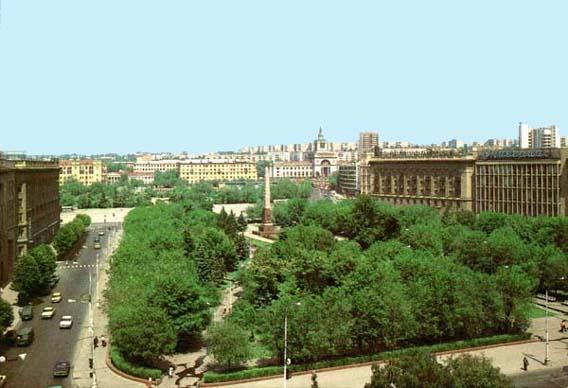
it is
a beautiful modern city with high buildings, schools, institutes,
universities, theatres
and
museums. Volgograd attracts a lot of tourists, especially
in spring and summer due
to
the warm climate, a plenty
of
fruit and vegetables and because of the Volga beach.
Volgograd
is an industrial city. There are a lot of factories
and plants.
The city is rich in sights
such as the
Fallen Fighters` Square,
the
Planetarium,
the
New Experimental Theatre,
the
Central Department Store,
the
Central Embankment,
the
Museum-Panorama of Stalingrad Battle
and others.
As
for me my favourite attraction
of Volgograd is… because…
Соседние файлы в предмете [НЕСОРТИРОВАННОЕ]
- #
- #
- #
- #
- #
- #
- #
- #
- #
- #
- #
Тема Волгоград на английском языке: достопримечательности, рассказ о городе. Достопримечательности волгограда на английском языке
Тема Волгоград на английском языке: достопримечательности, рассказ о городе
Volgograd is the capital of the Volgograd region [Волгэгрэд ис зэ кэпитал оф зэ Волгэград риджин] – Волгоград это административный центр Волгоградской области.
The city is the longest one in Russia, it is length is about 90 kilometers [Зэ сити ис зэ лонгест уан ин Раша, ит ис ленф ис эбаут найнтин километэрс] – Этот город является одним из самых протяженных в России, его протяженность составляет около 90 километров.
The city was built as a fortress in 1589 and called Tsaritsyn [Зэ сити вос билт эс э фотрис ин фивтин эйтин найн энд колд царицын] – Город был основан как крепость в 1589 году и назван Царицын. In 1925 the city received a new name, Stalingrad [Ин найнтин твенти файв зэ сити ресивд э нью нэйм, Стэлингрэд] – В 1925 году город получил новое название, Сталинград.
Volgograd has the status of “Hero City” [Волгэгрэд хэс зэ статус оф хироу сити] — Волгоград имеет звание Города-героя. In 1942 the city became the scene of an epic battle of World War II [Ин найнтин фоти ту зэ сити бикейм зэ сцин оф эн эпик батл оф Ворлд Вор ту] – В 1942 году город стал ареной легендарной битвы Второй Мировой Войны.
Square of the Fallens [Сквэа оф зэ фолэнз] — Площадь Павших борцов
It is the central and largest square of Volgograd [Ит ис зэ сэнтрал энд ладжест сквэа оф Волгэгрэд] – Это центральная и самая большая площадь Волгограда.
The Mamai Hill [Зэ Мамэй Хилл] – Мамаев Курган
It is a symbol of the city, architectural-and-sculptural complex is about 26 hectares [Ит ис э симбол оф зэ сити акитэкчэ-энд скалптчурал комплекс ис эбаут твенти сикс хэктэз] – Это символ города, архитектурно-скульптурный комплекс занимающий около 26 гектар.
The Motherland Calls [Зэ мазэлэнд колс] – Родина Мать зовёт
The height of this sculpture is 85 m [Зэ хейт оф вис скалпчэ ис эйтин фивтин метэс] – Высота этой скульптуры составляет 85 метров. It is the tallest statue of a woman in the world [Ит ис зэ толест статью оф э вумен ин зэ ворлд] – Это самая высокая статуя женщины в мире.
Volga–Don Canal [Волгэ-Дон кэнэл] — Волго-Донской канал
The canal connects the Volga and the Don rivers [Зэ кэнэл конэктс зэ Волга энд зэ Дон риверс] – Этот канал соединяет реки Волгу и Дон. Volga-Don Canal opened in 1952, the length of the waterway is 101 km [Волга-Дон кэнэл оупенд ин найнтин фивтин ту, зэ ленф оф зэ вотэвэй ис уан хандрид энд уан] – Волго-Донской канал открыт в 1952 году, протяженность водных путей составляет 101 км.
The Heroes` Alley [Зэ хирос Алли] – Аллея героев
On one side of the Alley a memorial to 192 heroes of the Soviet Union born in Volgograd [Он уан сайд оф зэ Алли э мемориал моньюмент ту уан хандрид ту хирос оф зэ Совьет Юнион] – На одной стороне аллеи Мемориал 192 Героям Советского Союза, родившимся в Волгограде.
On the other side there is a monument to 127 heroes of the Soviet Union who got the title during Stalingrad Battle [Он зэ авэ сайд вэа ис э моньюмент ту уан хандрид твенти севен хирос оф зэ Совьет Юнион ху гот зэ тайтл дьюрин Стэлингрэд Батл]- На другой стороне есть памятник 127 Героев Советского Союза, которые получили это звание в ходе Сталинградской битвы.
150slov.com
Волгоград
МИНОБРНАУКИ РОССИИ
Федеральное государственное бюджетное образовательное учреждение
высшего профессионального образования
«Волгоградский государственный социально-педагогический университет»
(АНГЛИЙСКИЙ ЯЗЫК)
Volgograd
Волгоград
2013
Пособие содержит методические указания и задания по теме «Волгоград (Volgograd)», предназначенные для студентов 1 курса дневного отделения неязыковых специальностей вуза, изучающих английский язык.
Составители:
доцент кафедры иностранных языков кандидат педагогических наук Н.И. Роговская,
доцент кафедры иностранных языков кандидат педагогических наук Т.Н. Сайтимова.
составление 2013 г.
Contents
UNIT I. The City of Volgograd: General Information…………………..
UNIT II. Volgograd Places of Interest……………………………………
UNIT III. Volgograd: Additional Information……………………………
UNIT IV. Revision………………………………………………………..
Unit I. The City of Volgograd: General Information Reading
-
Look through the new words before reading.
Vocabulary
a fortress – крепость
to defend – защищать
a trade route – торговый путь
the most important strategic point – самая важная стратегическая точка
to link – связывать
to remind – напоминать
the Mamayev Hill – Мамаев Курган
Pavlov House – Дом Павлова
the Destroyed Mill – Разрушенная Мельница
a factory – фабрика
a plant – завод
a sight – достопримечательность
the Fallen Fighters` Square – Площадь Павших Борцов
the Planetarium – Планетарий
the New Experimental Theatre – Новый Экспериментальный Театр
the Central Department Store – Центральный Универмаг
the Central Embankment – Центральная Набережная
the Museum-Panorama of Stalingrad Battle – Музей-панорама Сталинградской битвы
an attraction – достопримечательность
especially – особенно
due to – благодаря
-
Find the new words and word combinations in the text “Volgograd”. Read them aloud and translate.
-
Read and translate the text. Complete the last sentence.
Volgograd
Volgograd is situated in the South-East of the European part of Russia on the river Volga. It was founded in 1589 as a fortress, defending trade routes from the Tartars. It was named Tsaritsyn.
In the 19-th century it became a big industrial city and one of the most important strategic points in the Russian State. In 1925 the city was renamed as Stalingrad and in 1961 it got the name of Volgograd.
The city is famous all over the world for the victory of the Soviet soldiers and officers over the fascists in the Battle of Stalingrad during the Great Patriotic War. Many places of the city are linked with those war days and remind us of them. They are:the Mamayev Hill, Pavlov House, the Destroyed Mill and many others.
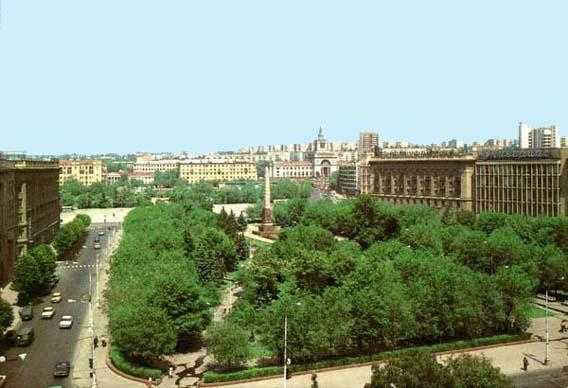
Volgograd is an industrial city. There are a lot of factories and plants. The city is rich in sights such as the Fallen Fighters` Square, the Planetarium, the New Experimental Theatre, the Central Department Store, the Central Embankment, the Museum-Panorama of Stalingrad Battle and others.
As for me my favourite attraction of Volgograd is… because…
studfiles.net
«My city is Volgograd» («Мой город – Волгоград»)
Разделы: Иностранные языки
Тип урока: Урок-беседа.
Оборудование: учебник, магнитофон, словари,
наглядные пособия: карта Волгограда, наглядные
пособия достопримечательностей Волгограда, при
возможности мультимедийный проектор для
демонстрации города и т.п.
Цели:
- Обеспечить в ходе урока усвоение студентами
темы «Мой город — Волгоград». - Продолжить развитие у студентов навыков чтения,
произношения, устной речи, перевода и письма. - Развить интерес к истории, традициям и нравам
родного города. - Развить стремление к изучению иностранного
языка.
Ход урока:
1. Организационный момент, рапорт дежурного (2
мин.)
Teacher: Good afternoon! Sit down, please! What date is it today?
Student: Today is …
Teacher: Who is absent today?
Student: Nobody is absent today. All students are present. All students are at the
lesson.
Teacher: OK. Fine. Sit down, please.
2. Фонетическая зарядка:
Teacher: Look at the blackboard! There are some difficulties on it:
На доске заранее подготовлено:
The Great Patriotic War, higher educational institutions,
Magnificent, legendary Hero-City, serious consequences
Hall of Glory, Statue of Motherland, Embankment.
Преподаватель читает, и студенты хором
повторяют за ним.
Teacher: Translate me, please!
Преподаватель называет слова или
словосочетания, студенты переводят.
3. Постановка темы урока:
Teacher: There are many cities in our country, most of them are very beautiful and
large. But Volgograd is well-known abroad, because our city is a legendary
Hero-City all over the world. And as you have understood the theme of our lesson is “My
city is Volgograd”
4. Контроль домашнего задания. Работа над
текстом «Volgograd».
Teacher: Your homework was the text. You have to read and translate it at home. Now
we will work on it. I read the text once, listen to me please and notice all
difficulties in the text. And now let’s start to work.
Преподаватель читает текст, текст может быть
так же записан на кассету и включен для
прослушивания. Наиболее оригинальным было бы,
если бы текст читал носитель изучаемого языка.
Student: Volgograd is a big city with the population of more than one million
people. Magnificent, green and beautiful Volgograd stands on the Volga as a monument.
Teacher: Translate me, please. Look at the blackboard. You see a map
of our city on it. Yes, sure. Our city is very beautiful, magnificent and green.
Student: Volgograd was founded in 1589 as a small fortress on the Russian river and
quickly grew into a city with developed industry and culture.
Teacher: Yes. You are right. At first our city was a small fortress but now it is
one of the biggest city in our country. It lasts over 80 km
Student: The city has changed its name three times: Tsaritsyn – Stalingrad –
Volgograd. In the years of the Great Patriotic War the battle of Stalingrad lasted for 200
days and nights. Stalingraders stood to the death, but defended the city. Our warriors
gave the country more that112 herous: Putilov, Serdukov, Panikaha, etc. Glorious generals
commanded and won the battle: Khukov, Shumilov, Tchuikov, Rokossovsky and others. After
the war the city was ruined. Our legendary Hero-City stands as a memorial to the people
who defended it during the war and to those, who repaired it after the war.
Teacher: Look at the monitor. What square is this?
Student: This is the square of Fallen Warriors.
Teacher: (преподаватель демонстрирует Площадь
Павших Борцов, или прикрепляет картинку с данным
изображением) : Yes. You are right. This is the square of Fallen
Warriors. This square is well-known here in Volgograd. There was a wonderful Cathedral
here. Who knows its name?
Если студенты знают, то отвечают.
Teacher: There was Alexander Nevski Cathedral but it was ruined in the 30-th years
of the 19-th century. There was a center of the city. There was a market here. A lot of
seller sold their goods. What theatres do you know in our city?
Student: Drama Theatre…
Teacher (демонстрация НЭТ): Yes. You are right.
But at first there was a building of Science. The Hotel “Volgograd” was called as
“Stolitschnyje Nomera”. It was wooden and was burned out during the war.
Teacher: Who know, what else there is here?
Student: The Hotel “Intourist”.
Teacher: You are right. This hotel was built after the war in 1951 by architect
Goldman and it is a symbol of the friendship among different nations. Everybody from
different countries can visit our city now. There aren’t enemies now. Everything is very
symbolic in out city. For example, the name of the Mira Street “Piecestreet” means
friendship again…
Teacher (работая у монитора): You know now that there are many
places of interests here in Volgograd. Who knows about a monument of the square of the
“Fallen Warriors”?
Если студенты знают, то отвечают.
Teacher (демонстрирует обелиск Павшим Борцам): This
a monument for the Fallen Warriors. It is a massgrave. And what else are there on the
square of the Fallen Warriors?
Если студенты знают, то отвечают.
Teacher: There is a grave if Ruben Ibarruri. He was a son of Dolores Ibarruri. She
was a president of Communist Party. They were from Spain. On the 9-th day of the war Ruben
Ibarruri was in the front. He was a death wounded man and he has his grave here in
Volgograd and it is a symbol, too. It means that the war was international. In general,
this place of our city is a symbol of friendship and this monument is a symbol against
terrorism.
Teacher: Look at the monitor. There are two graves here, too. The grave of Vladimir
Kametchikov and the grave of Haffis Fattjachuldinov. They are heroes, too. Haffis
struggled with 10 soldiers in the south of the city, and Kametchikov was Volgograder and
perished here in his native city for the city…
Student: The symbol of the city is Mamaev Hill with its Hall of Glory, Statue of
Motherland. You can hardly keep tears visiting this complex. Alley of Heroes,
Panorama-Museum, Pavlov House and also the places, which attract people.
Teacher (демонстрация перечисленных
достопримечательностей): Pavlov-House is well-known in Volgograd
and overseas, too. Everything was ruined on the square of Pavlo-House. But only this House
was.. Pavlov and three soldiers struggled here on the third floor of the house. They had
been struggling for 2 days. And 24 soldiers with lieutenant Afanasjev had been struggling
on the first floor of the house. The battle had lasted for 58 days. This house deals with
the mane of one woman. Who knows her name?
Если студенты знают, то отвечают.
Teacher: Her name was Tcherkassova. She built this house again like it was before
the war and the people can live in it.
Teacher: Not far from the House there is Panorama-Museum. This is the third
Panorama on the territory of our country. There are 2 Panoramas in our country. In Moscow
there is “Borodino Battle” and in Volgograd “Stalindrad Battle”. And you can see,
of course, the ruined Mill near this Panorama – Museum. The war- technique can be seen
before Panorama Museum and Mill
Teacher: As for Mamaev Hill, so it is difficult to speak. Many people were
perished here. There are a lot of monuments on Mamev hill. You can visit this place of
interests. But some people say that it is very difficult to visit it, because they mean
that this monument is a very big grave for all soldiers, who defended the city during the
war. We can read a lot of names here. And Statue of Motherland is the biggest Statue all
over the world.
Демонстрация достопримечательностей
Волгограда.
Student: I am proud that I live in Volgograd, the city which gave us such famous
people as comporses Pakhmutova, Panomarenko, poets Agashina, Lukonin, actors: Rybnikov,
Lapikov, Smoktunovsky.
Teacher (демонстрирует фотографии выдающихся
людей Волгограда): Yes, our city has a lot of famous people, who knows
all over the world. There is a monument for a poetress Agashina in our city, near Medicine
University.
Student: Now my city is an industrial, cultural, education and sport center. We
have a lot of plants,factories, offices, business-centers here.
Teacher: Name me, please, what factories, business-centers do you know in our city?
Student: It is a city of students. There are over ten higher education
institutions, a lot of colleges and technical schools here. I love my city, its green
squares, its Embankment, charming rest-centers.
Teacher: Name me, please, how many universities do you know in our city?
Если студенты знают, то отвечают.
5. Этап контроля:
Now you know more about Volgograd. And answer my questions to the text….
6. Завершение урока:
Your hometask is…
Your marks are….
Thanks a lot. Prepare for your homework. Learn English. Good-bye!
xn--i1abbnckbmcl9fb.xn--p1ai
Тема Волжский на английском языке: достопримечательности, рассказ о городе
Волжский — город моей судьбы — эту надпись на площади Ленина видят тысячи жителей и гостей города. Ведь, на самом деле, это место уникально. Это один из самых зеленых уголков России, и самый красивый в Волгоградской области.
Volzhsky — the city of my fate — this inscription on Lenin Square is seen by thousands of residents and visitors of the city. After all, in fact, this place is unique. This is one of the greenest parts of Russia, and the most beautiful in the Volgograd region.
Тут встречаются признаки проживания золотоордынских племен. Их точное количество не установлено, они располагались вдоль реки Ахтубы. There are signs of the existence of the Golden Horde tribes. Their exact number is not established, they were located along the Akhtuba River.Здесь есть возможность хорошо отдохнуть летом: песчаные берега рек, богатая растительность вдоль побережья дают возможность расслабиться на природе. There is an opportunity to have a good rest in summer: the sandy banks of rivers, rich vegetation along the coast give an opportunity to relax in nature.
Достопримечательности
Парк можно смело назвать украшением города, особенно в тёплое время года, когда деревья обрамлены зелёной листвой и клумбы оформлены яркими цветами. Это место расположено в центре города и занимает площадь в 14 га. Очень впечатляющая цифра! Основан парк «Гидростроитель» в 1951 году, именно в те далёкие года и началась первая посадка деревьев разных видов.
The park can be called an adornment of the city, especially in the warm season, when the trees are framed by green foliage and the flower beds are decorated with bright colors. This place is located in the center of the city and covers an area of 14 hectares. Very impressive figure! The park «Gidrostroitel» was founded in 1951, it was in those distant years and the first planting of trees of different species began.
Старая мельница это строение будет особенно интересно любителям истории. Здание, не сломленное годами — так его можно назвать. Возведено оно было в 1911 году и устояло по сегодняшний день, несмотря на то, что в советское время её даже пытались взорвать, чтобы убрать, как неподходящее под общую архитектуру здание. Однако построено оно настолько крепко, что осталось целым. Расположена мельница в 36 квартале.
An old mill this building will be especially interesting for history lovers. The building, not broken by years — so it can be called. It was built in 1911 and survived to this day, despite the fact that in Soviet times it was even attempted to blow up to remove it as unsuitable for the general architecture of the building. However, it is built so tightly that it remains intact. The mill is located in the 36th quarter.
Диалог
- Какие площади есть у нас в городе?
- Площадь Труда, площадь Ленина, площадь Свердлова , площадь Строителей.
- Какие памятники есть у нас в городе?
- Памятники Д.М.Карбышева, А.С.Пушкина, В.И.Ленина,Ф.Логинова и памятник воинам–интернационалистам.
- Кто был главным архитектором – строителем нашего города?
- Ф.Логинов
- Какие две реки протекают вблизи г. Волжского?
- Волга иАхтуба
Перевод:
- What areas do we have in the city?
- The area of Labor, Lenin Square, Sverdlov Square, Stroiteley Square.
- What monuments do we have in the city?
- Monuments of D.M.Karbyshev, A.Pushkin, V.I. Lenin, F.Loginov and a monument to soldiers-internationalists.
- Who was the chief architect — the builder of our city?
- F.Loginov
- Which two rivers flow near the city of Volzhsky?
- Volga and Akhtuba.
150slov.com
Презентация на английском языке для внеурочных мероприятий «Экскурсия по историческим достопримечательностям Волгограда».
Ladies and gentelmen! Gymnasia №10 welcomes you. We are going to show you some sights of Volgograd. We offer you a wonderful excursion «Historical Volgograd».
Volgograd is one of the most beautiful old cities of Russia. It is located in the south-eastern European part of Russia. The city was built as a fortress on the right bank of the Volga. The date of its birth is July 2, 1589.
Now we are in the square devoted to the Fallen Fighters. We have only 5 minutes to see this square. Arter that the modern comfortable tourist bus will take us to the panoramic museum «The Battle of Stalingrad» and as it has been promised you will be able to see the fascinating scenery of Volgograd from the most beautiful embankment of the river.
So, let’s go to the Brothers grave and during our walk I will tell you about all around us. Pay attention to this building. It is the Volgograd Post office which was constructed in 1955. To the left you can see hotel «Intourist» built in a classical style in 1958. Here you can also see the Drama Theatre with New Experimental Theatre in it. It was built by a merchant Repnikov in 1915. It was ruined during the war but was rebuilt in 1952. In 1989the New Experimental Theatre found hisplace seat here. Right in front of it there is a monument to Alexander Nevsky which was erected on February, 24, 2007 in front of the theatre. A. Nevsky is considered to be a celestial protector of Volgograd. Now we’ve come to the Brothers grave of the city’sdefenders in 1919. A 6 m high obelisk was constructed on this place. In 1942 about 100 fighters, defenders of Stalingrad were buried here. And in 1957 a new black-and-red granite 26 m. high obelisk was erected on the grave. The Eternal Flame has been here since 1963. Since 1966 one has been able to see the change of the guard here. The best schoolboys and schoolgirls stay here in the guard. Not far from Eternal Flame there is an international grave of 3 fighters. They defended Stalingrad from the fascists: a Spaniard Ibarruri Ruben Ruis, a Russian pilot Kamenshikov Vladimir Grigorjevich and a Tartar Hafis Fatjahuddinov. In the square of the Fallen Fighters you can see a poplar-tree. It is the only tree left after Stalingrad Battle. That`s why it is covered with war scars. In 1975 a granite plate was put here. There are such words on it: “Nature – historical monument. This poplar-tree brought his life through the great battle”.
The first phase of our excursion is done. Now we are going to the panoramic museum «The Battle of Stalingrad» in the tourist bus. Look, it’s already here! Let’s go! It will take us only 5 minutes to get to the museum.
So, now we are standing right in front of the museum.
Not far from Pavlov House there is the State historical memorial museum “Stalingrad Battle”. This museum exhibits the military equipment that is demonstrated in the open air. You can see the famous Soviet “Katusha” (a military car with reactive artillery) here.Also you can see the guns of different calibers, which were produced in the period of the war.In front of the museum there is a column with the inscription: ”According to the call of our Motherland and party the Soviet people came here to defend the freedom and honor of the people, the achievements of the Great October. Here, on this land, the war was turned back; the soldiers made it go from the darkness to the light, from the slavery to the freedom, from death to life”.On the other side of the column we can read the words said by I. Stalin: “It was the dawn of the German fascist Army”.Pay attention to the Marshal Zhukov`s monument which is in front of the museum. It is the entrance to the museum – the panorama”Stalingrad Battle”.Inside the museum there is a bronze composition of the war’s great leaders: Churchill, Rusevelt and Stalin met at summit in Sochi in 1945. It is an important exhibit of the museum. It took us only 6 minutes, so you can look around yourself and we will meet in 3 minutes.
Now we are going to the Volgograd River Port. We will get to it in 4 minutes. Let’s go!
So we are standing right in front of the River Port. The Volgograd River Port JSC owns and operates a marine port in the South of Russia. The company provides cargo, and city and suburban passenger transportation services; organizes pleasure trips; offers ferry and ship. It handles and stores cargoes, such as metal production, steel pipes and scrap metal. The company was founded in 1862 and is based in Volgograd, the Russian Federation.
So, this is the end of our excursion. We hope you have enjoyed it. You can look around and we will meet near the bus in 5 minutes. Enjoy your time. Thank you for coming. We hope it is not our last meeting. Good luck!
Thank you for your attention!
infourok.ru
Сочинение про Волгоград на английском языке не менее 70 слов
Volgograd is one of the largest historical cities located in the South-East of the European part of Russia. The city was first mentioned in 1589. This date is considered to be the city foundation year. Nowadays Volgograd is home to 1 million 18 thousand people. It occupies the 13th place among all Russian cities based on population. Its territory is home to people of different nations. Most people are Russians who account for 90 percent of the population, the second largest group is formed by the Kazakhs, followed by the Ukrainians and the Armenians. The citys climate is characterized by strong temperature changes, hot and long summers and mild winters. Volgograd is a large city with developed industry. The most popular are such industries as metallurgy, engineering, metalworking, chemical plants and power generation. There are many cultural interesting places in the city, such as theaters, museums, cinemas, exhibitions and so on. Thanks to its outstanding history Volgograd can boast of some unique monuments, which are popular with both local citizens and tourists. The main attraction of the city is Mamaev Kurgan. This largest memorial complex was created in the memory of the Great Patriotic war. Around the complex there are different monuments dedicated to specific moments of the Staliningrad battle. This memorial is crowned by the huge 85 meter high «Motherland calls». The state museum-panorama of Stalingrad battle is very popular among tourists. Here you can see more than 130 thousand exhibits, telling about the heroic past of the city. In addition, the museum includes the largest Russian panorama dedicated to Stalingrad battle. This huge, 120×6 meter, painting is a magnificent work of art. In general, this hero town contains a large amount of monuments, exhibition halls and another interesting historical places where everyone can find place after his own heart.
Оцени ответ
shkolniku.com
Написать на английском про Волгоград о всех достопримечательностях
Volgograd — a city in the south-east of the European part of Russia, the administrative center of Volgograd region, city-hero.
The population — 992 million people (2006) (13th place in Russia)
The city is located on the right bank of the Volga River in its lower reaches. Continental climate. Average rainfall — 330 mm per year. Average temperatures in January? 9,6 ° C (up to? 35 ° C), in July +24,2 ° C (up to +40 ° C). Subject to extreme temperatures.
City from 1589 to 1925 was known as Tsaritsyn, and from 1925 to 1961 — Stalingrad.
Mamaev Kurgan — «main height of Russia.» During the Battle of Stalingrad took place here some of the most intense fighting. Today at Mamaev Kurgan a monument-ensemble «Heroes of the Battle of Stalingrad.» Center of the composition — the sculpture «The Motherland Calls!».Panorama «The defeat of German forces at Stalingrad» — located on the waterfront of Central. Opened in 1982.The ruins of the old mill — the only remnants of war unrestored building in town.»The House of Fame soldiers» or, as it is called by the people «Pavlov’s House» — a brick building that dominates the surrounding area.
Avenue of Heroes — a small pedestrian street connecting the embankment of the Volga River and the area of Fallen Fighters.September 8, 1985, was opened a memorial monument dedicated to the Heroes of the Soviet Union and the Knights of the Order of Glory full, native of Volgograd region and the heroes of the Battle of Stalingrad. Artwork made Volgograd branch Art Fund of the RSFSR under the leadership of artist M. Ya Pyshty. In writing team included chief architect AN Klyuchischi, architect A. Belousov, designer L. Podoprigora artist EV Gerasimov. On the monument names (surname and initials) 127 Heroes of the Soviet Union, received the title for his heroism in the Battle of Stalingrad in 1942-1943, 192 Heroes of the Soviet Union — the natives of the Volgograd region, three of them twice Hero of the Soviet Union, and 28 members of the Order of Glory of three degrees.
In Volgograd, there is quite a bit of historical monuments, not related to the Great Patriotic War of 1941-1945. This is due to the fact that for two days, 22 and 23 August 1942 in the bombing of German troops were killed, more than 90% of the northern part of the city (to the floodplain Queen). Suffice to say that in the central region remains one building habitable.
Square of Fallen Fighters (up to February 8, 1920 — Alexander Square) is one of the few monuments of the city, connected not only with the Second World War. The central area of the city. Was named in honor of all the defenders of the city died in the Civil War. Above the mass grave, located directly on the square, the obelisk was erected in their honor. During the Battle of Stalingrad, the area became the scene of fierce fighting. February 4, 1943 the grave was made of the remains of more than one hundred dozahoronenie defenders of Stalingrad. Now in place of their burial towers 26-meter stele made of black and red granite. February 1, 1963 in the Square of Fallen Fighters eternal flame was lit in memory of the courage and heroism of the defenders of the city.
Area Dzerzhinsky — center Traktorozavodskogo district. In 1926, the Supreme Council of National Economy of the USSR, it was decided to construct the Stalingrad tractor factory, the first in the country. Was selected, 14 kilometers from the city center, and 12 July 1926 the ceremony of laying the tractor plant. In memory of the Dzerzhinsky after his death in 1926, the workers and the public Stalingrad petitioned the Central Executive Committee of the USSR on assignment plant under construction in his name. To date, the main through-factory gate, built in the postwar period, the project architect, professor of the Moscow Nikolayev are the main compositional center of Dzerzhinsky Square. In 1932 it was decided to build on the square in front of the monument by the Dzerzhinsky. The author of the monument was a People’s Artist of the USSR, sculptor SD Mercury. First, on the pedestal was installed temporary model, and in 1936 a monument in bronze. In 1960, the pedestal of the monument restored and lined with granite. The sculpture — 4.3 m pedestal — 6.48 pm During the Battle of Stalingrad, 1942-1943. monument was damaged by shrapnel and mortar shells, bomb explosions, but all survived the battle. Now Dzerzhinsky monument of historical importance as one of the few remaining in the city since before the war.
creditomart.ru

